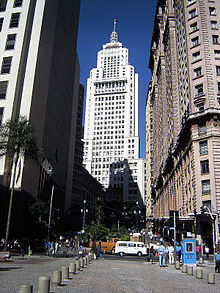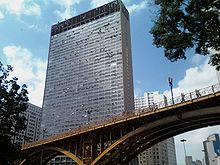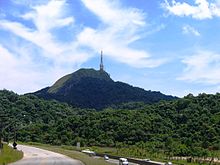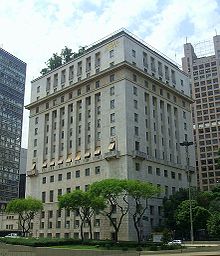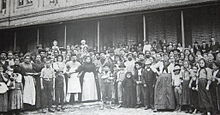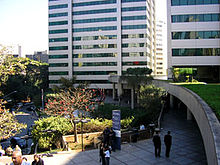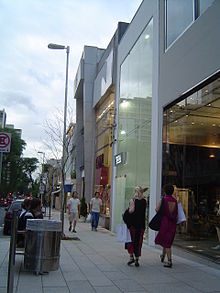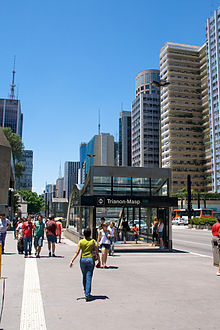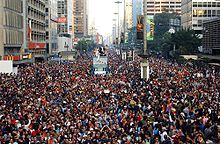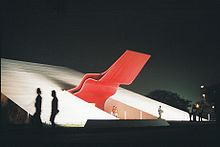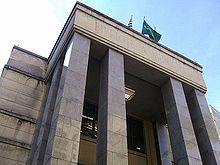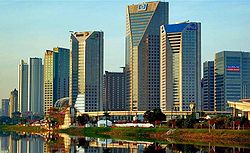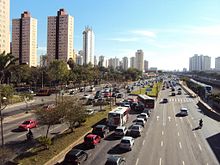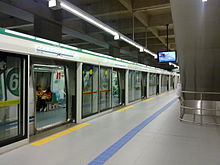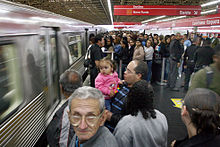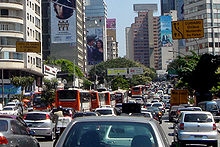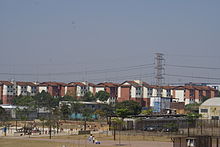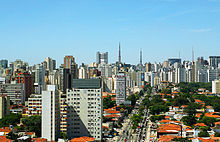- São Paulo
-
This article is about the city. For the state, see São Paulo (state). For other uses, see São Paulo (disambiguation).
São Paulo — Municipality — Município de São Paulo
Municipality of São PauloPhoto montage of the city of São Paulo. From the top, left to right: São Paulo Cathedral; United Nations Business Center; São Paulo Museum of Art on Paulista Avenue; Paulista Museum; Bandeiras Monument; Octávio Frias de Oliveira Bridge; and overview of the historic downtown from Altino Arantes Building. 
Flag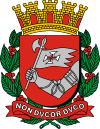
SealNickname(s): Terra da Garoa (Land of Drizzle) and Sampa Motto: "Non ducor, duco" (Latin)
"I am not led, I lead"Location in Brazil Coordinates: 23°33′S 46°38′W / 23.55°S 46.633°WCoordinates: 23°33′S 46°38′W / 23.55°S 46.633°W Country  Brazil
BrazilRegion Southeast State  São Paulo
São PauloFounded 1554 Government – Mayor Gilberto Kassab (Democrats) Area – Municipality 1,522.986 km2 (588 sq mi) – Metro 7,943.818 km2 (3,067.1 sq mi) Elevation 760 m (2,493.4 ft) Population (2011)[1] – Municipality 11,316,149(1st) – Density 7,216.3/km2 (18,690.1/sq mi) – Metro 19,672,582 – Metro density 2,469.35/km2 (6,395.6/sq mi) Demonym Paulistano Time zone UTC-3 (UTC-3) – Summer (DST) UTC-2 (UTC-2) Postal Code (CEP) 01000-000 Website City of São Paulo São Paulo (Portuguese pronunciation: [sɐ̃w ˈpawlu] (
 listen), Saint Paul; English: /ˌsaʊ ˈpaʊloʊ/) is the largest city in Brazil, the largest city in the southern hemisphere and South America, and the world's seventh largest city by population. The metropolis is anchor to the São Paulo metropolitan area, ranked as the second-most populous metropolitan area in the Americas and among the five-largest metropolitan areas on the planet.[2] São Paulo is the capital of the state of São Paulo, the most populous Brazilian state and exerts strong regional influence in commerce and finance as well as arts and entertainment. São Paulo maintains strong international influence and is considered an Alpha World City.[3] The name of the city honors Saint Paul.
listen), Saint Paul; English: /ˌsaʊ ˈpaʊloʊ/) is the largest city in Brazil, the largest city in the southern hemisphere and South America, and the world's seventh largest city by population. The metropolis is anchor to the São Paulo metropolitan area, ranked as the second-most populous metropolitan area in the Americas and among the five-largest metropolitan areas on the planet.[2] São Paulo is the capital of the state of São Paulo, the most populous Brazilian state and exerts strong regional influence in commerce and finance as well as arts and entertainment. São Paulo maintains strong international influence and is considered an Alpha World City.[3] The name of the city honors Saint Paul.The metropolis has significant influence nationally and internationally, in terms of culture, economy and politics. It houses several important monuments, parks and museums such as the Latin American Memorial, the Museum of the Portuguese Language, São Paulo Museum of Art, the Ibirapuera Park and the Paulista Avenue, which is the most important financial center of São Paulo. The city holds many high profile events, like the São Paulo Art Biennial, the Brazil Grand Prix Formula 1 Sao Paulo, Sao Paulo Fashion Week, and the São Paulo Indy 300.
It is home to the São Paulo Stock Exchange, the Future Markets, and the Cereal Market Stock Exchanges (the second largest stock exchange in the World, in market value).[4] São Paulo has been home to several of the tallest buildings in Brazil, including the building Mirante do Vale, Italia, Altino Arantes, North Tower of the UNSCOM (United Nations Centre Enterprise) and many others.
People from the city of São Paulo are known as paulistanos, while paulistas designates anyone from the whole of São Paulo state, including the paulistanos. The city's Latin motto, which it has shared with the battleship and the aircraft carrier named after it, is Non dvcor, dvco, which translates as "I am not led, I lead."[5]
The city, which is also colloquially known as "Sampa" or "Cidade da Garoa" (city of drizzle), is also known for its unreliable weather, the size of its helicopter fleet, architecture, gastronomy, severe traffic congestion, and multitude of skyscrapers.[6]
History
The first coastal settlement in Brazil, São Vicente was founded in 1532.[7] It was the first permanent Portuguese colony in the New World.[7] Twenty two years later the Tibiriçá Chief and Jesuit missionaries Manuel da Nóbrega and José de Anchieta founded the village of São Paulo dos Campos de Piratininga 68 kilometres (42 mi) inland from São Vicente, on January 25, 1554.[7] The clergymen established a mission at the Colégio de São Paulo de Piratininga, aimed at converting the Tupi–Guarani indigenous Brazilians to the Catholic faith, as well as make it easier for the Portuguese crown to rule them. Anchieta is said to have killed a native, which brings a degree of protest from Indian rights groups against his canonization by the Vatican. The Jesuits were later also often at odds with the Portuguese authorities, mainly the Marquês de Pombal, who eventually expelled them from Brazil for protecting converted natives in their missions. Located just beyond the Serra do Mar cliffs, above the port city of Santos, and close to the Tietê River, the new settlement became the natural entrance from the South East coast to the vast and fertile high plateau to the West that would eventually become the richest Brazilian state.
São Paulo officially became a city in 1711. In the 19th century, it experienced economic prosperity brought about through coffee exports shipped from the neighboring city of Santos.
After the abolition of slavery in 1888, waves of immigrants from Portugal, Italy, Spain and other European countries emigrated to São Paulo in order to "bleach the race," as Luso-Brazilian authorities feared Brazil's black population would grow far more than other groups. These Europeans were granted lands as incentives to immigrate and some worked in an indentured fashion at coffee plantations. Newcomers and their descendants ended up "making the America," as they said in Italian and Portuguese, and some of Brazil's greatest entrepreneurs have Italian, Portuguese, and German last names such as Mattarazzo, Diniz, and Mueller.
 The Martinelli Building, a symbol of São Paulo's iconic early 20th century architecture.
The Martinelli Building, a symbol of São Paulo's iconic early 20th century architecture.
By the beginning of the 20th century, the coffee cycle had plummeted due to, among other factors, a sharp decline in international coffee prices. With the Wall Street Crash of 1929, coffee barons started losing their influence and status. The Paulistan economy looked for other alternatives such as sugar cane and the production of alcohol. With the difficulties brought about by World War II, when industrialized items had difficultly reaching Brazil, and following the national incipient trend of import-substitution, São Paulo began industrializing for domestic consumption. Brazil already showed a pattern of huge importation of most fashionable and manufactured products from Europe, which was maintained well into the late 20th century, and created huge trade deficits despite substantial coffee and sugar exports.
Local entrepreneurs then started investing in the industrial development of São Paulo, attracting new contingents of immigrants to the city, mainly Italians. In addition to Europeans, Japanese and Syrian and Lebanese immigrants arrived in large numbers in the first half of the 20th century. Along the 20th century, the booming economy of the city also attracted huge waves of migrants from the poorest regions in Brazil, such as the Northeast. São Paulo maintained a high economic growth rate through the 1920s, driven by interrelated streams of immigration, rapid industrialization, and investment. In the early 1920s the Sampaio Moreira Building reached an unprecedented 14 stories, and by the end of the decade the Martinelli Building attained more than twice that height. Growing fleets of automobiles and diesel buses allowed hordes of service workers to commute from their outlying homes to jobs in the city center.
However, due to competition with many other Brazilian cities, which sometimes offer tax advantages for companies to locate manufacturing plants there, São Paulo's main economic activities have gradually left its industrial profile in favour of the services industry in the late 20th century. The city is home to a large number of local and international banking offices, law firms, multinational companies and consumer services. Although a modern face had emerged in São Paulo's better areas by the 1930s, larger portions were basically unchanged. São Paulo had lacked any city plan before 1889, and no zoning law was passed until 1972. Indeed, well into the 20th century much of the city retained a colonial aspect, with narrow unpaved streets, shabby buildings, and a few old churches of Jesuit and Franciscan styles.
In 1924 the city was bombed during the Tenente revolts. Between 1920 and 1940 the population more than doubled, reaching 1.3 million. Although Rio de Janeiro had itself grown spectacularly during this period, São Paulo trailed it by only 460,000 inhabitants and would leapfrog ahead within two decades. During 1939–45 the engineer-mayor Francisco Prestes Maia built the multilane Avenida 9 de Julho and widened numerous other streets despite resistance from displaced residents. By 1947 the new star of São Paulo's skyline was the São Paulo State Bank building, and, starting with the Mário de Andrade Municipal Library, the city's architecture moved beyond the short period of Art Deco design. By 1950 São Paulo had grown to a metropolis of 2.2 million compared to Rio's 2.4 million, but a decade later São Paulo led with 3.7 million to Rio's 3.3 million, thus solidifying its reputation as one of the world's most dynamic urban centres. Famed architect Oscar Niemeyer was lured from Rio to design the sinuous curves of the Copan Building, and the Itália Building became its towering neighbour. The highly imaginative São Paulo Art Museum (begun in 1956 and completed in 1968) was built over the juncture of Avenida 9 de Julho and eight-lane Avenida Paulista.
In the 1960s São Paulo came to include almost half of the population of the State of São Paulo (Brazil's most populous state) and to account for about one-third of the country's total industrial employment. Because automobiles were becoming a São Paulo family staple, expressways were built along the canalized Tietê and Pinheiros rivers in 1967, and the Bandeirantes expressway provided access to the city center. Highway expansion continues to be an ongoing process because the roads running alongside the rivers are among the heaviest used in the country. However, no amount of highway construction and street widening could more than briefly alleviate the intolerable traffic congestion. Construction of a subway system was begun in the late 1960s in hopes of improving the situation, and new subway lines continue to be expanded and added and enhanced.
Despite its many woes, São Paulo remains a business hub of Latin America. Having prospered first with the coffee industry, and later with industrialization, in the early 21st century it expanded into the tertiary, or services sector. Its huge market (about 20 million people in greater São Paulo) is a magnet for multinational corporations. Thanks to events such as the Feira Bienal Internacional de Arte, and its reputation for hosting cutting-edge music concerts, it has become something of a cultural center as well. Economic growth and exportation of goods has lifted employment and wages. The murder rate has dropped by almost a quarter since its peak.
The historic center profited with the return of the city's government and the arrival of private universities, although businesses continue to move out to new boom neighborhoods such as Itaim and Berrini. São Paulo also claims to attract more visitors (mostly, but no longer exclusively, on business) than Rio de Janeiro, testimony of the intense rivalry between the two metropolises.
Geography
Physical setting
São Paulo is located in Southeastern Brazil, in southeastern São Paulo State, approximately halfway between Curitiba (Capital of Paraná State, previously part of São Paulo State) and Rio de Janeiro (former capital of Brazil and now capital of the State which bears the same name). The city is located on a plateau located within the Serra do Mar (Portuguese for "Sea Range"), itself a component of the vast region known as the Brazilian Highlands, with an average elevation of around 799 metres (2,621 ft) above sea level, although being at a distance of only about 70 kilometres (43 mi) from the Atlantic Ocean. This distance is covered by two highways, the Anchieta and the Imigrantes, (see "Transportation" section below) that roll down the range, leading to the port city of Santos and the beach resort of Guarujá. Rolling terrain prevails within the urbanized areas of São Paulo except in the northern area of the city, where the Serra da Cantareira Range boasts higher elevations and a sizable remnant of the Atlantic Rain Forest. The entire region is very stable tectonically, and no significant seismic activity has ever been recorded.
See also: Water management in the Metropolitan Region of São PauloThe Tietê River, and its tributary, the Pinheiros River, were once important sources of fresh water and leisure for São Paulo. However, heavy industrial effluents and wastewater discharges in the later 20th century caused the rivers to become heavily polluted. A substantial clean-up program for both rivers is underway, financed through a partnership between local government and international development banks such as the Japan Bank for International Cooperation.[9] Neither river is navigable in the stretch that flows through the city, although water transportation becomes increasingly important on the Tietê river further downstream (towards South, near river Paraná), as the river is part of the River Plate basin.
There are no large natural lakes in the region, but the Billings and Guarapiranga reservoirs in the southern outskirts of the city are used for power generation, water storage, and leisure activities, such as sailing. The original flora consisted mainly of a great variety of broadleaf evergreens. Today, non-native species are common, as the mild climate and abundant rainfall permit a multitude of tropical, subtropical and temperate plants to be cultivated, with eucalyptus being especially ubiquitous.
Climate
The city has a monsoon-influenced humid subtropical climate (Cfa), according to the Köppen classification.[10] In summer, mean temperatures are between 17 °C (63 °F) and 28 °C (82 °F), and 32 °C (90 °F) on the hottest days. In winter, are between 11 °C (52 °F) and 23 °C (73 °F), and 6 °C (43 °F). on the coldest days. The highest temperature recorded was 35.3 °C (95.5 °F) on November 15, 1985.[11] and the lowest recorded was −2 °C (28 °F) on August 2, 1955, and on the same day −3.8 °C (25.2 °F) was recorded unofficially. The average temperatures throughout the year are similar to those of Sydney and Los Angeles. The Tropic of Capricorn, at about 23°27' S, passes through north of São Paulo and roughly marks the boundary between the tropical and temperate areas of South America. Because of its elevation, however, São Paulo enjoys a distinctly temperate climate.[12]
Rainfall is abundant, amounting to an annual average of 1,454 millimetres (57.2 in).[13] It is especially common in the warmer months average of 219 millimetres (8.6 in), and decreases in winter, average of 47 millimetres (1.9 in). Neither São Paulo nor the nearby coast has ever been hit by a tropical cyclone, and tornadic activity is uncommon. Snow flurries were reported officially only once, on June 25, 1918. During late winter, especially August, the city experiences the phenomenon known as "veranico" or "verãozinho" ("little summer"), which consists of a bout of unusually hot and dry weather, sometimes reaching temperatures well above 28 °C (82 °F). On the other hand, relatively cool days during summer are fairly common when persistent winds blow from the ocean. On such occasions daily high temperatures may not surpass 20 °C (68 °F), accompanied by lows often below 15 °C (59 °F).
Climate data for São Paulo (1961 - 1990, records lows since 1931) Month Jan Feb Mar Apr May Jun Jul Aug Sep Oct Nov Dec Year Record high °C (°F) 34.2
(93.6)34.6
(94.3)33.6
(92.5)31.3
(88.3)29.8
(85.6)28.9
(84.0)29.3
(84.7)33
(91)37.4
(99.3)34.4
(93.9)35.2
(95.4)35.7
(96.3)37.4
(99.3)Average high °C (°F) 27.4
(81.3)28
(82)27.3
(81.1)25.1
(77.2)23
(73)21.7
(71.1)21.8
(71.2)23.3
(73.9)23.9
(75.0)24.7
(76.5)25.9
(78.6)26.3
(79.3)24.5 Daily mean °C (°F) 22.2
(72.0)22.4
(72.3)21.7
(71.1)19.8
(67.6)17.6
(63.7)16.4
(61.5)15.8
(60.4)17.1
(62.8)17.8
(64.0)19
(66)20.3
(68.5)21.2
(70.2)18.5 Average low °C (°F) 18.7
(65.7)18.8
(65.8)18.2
(64.8)16.3
(61.3)13.9
(57.0)12.3
(54.1)11.7
(53.1)12.8
(55.0)13.9
(57.0)15.3
(59.5)16.5
(61.7)17.8
(64.0)14.5 Record low °C (°F) 10.2
(50.4)11.2
(52.2)10.9
(51.6)6
(43)5.2
(41.4)0.9
(33.6)0.2
(32.4)−2.2
(28.0)2.1
(35.8)4.2
(39.6)6.9
(44.4)7.3
(45.1)−2.2
(28.0)Precipitation mm (inches) 240
(9.45)250
(9.84)160
(6.3)80
(3.15)70
(2.76)60
(2.36)40
(1.57)30
(1.18)70
(2.76)130
(5.12)140
(5.51)190
(7.48)1,460
(57.48)Avg. precipitation days 18 16 13 9 9 6 7 7 9 11 13 16 134 Sunshine hours 148.8 150.8 145.7 141.0 151.9 144.0 164.3 155.0 126.0 136.4 144.0 130.2 1,738.1 Source no. 1: INMET — Clima[14], Hong Kong Observatory[15] for data of sunshine hours Source no. 2: World Weather Information Service[16], for data of precipitation days Law and government
See also: List of Mayors of São PauloSão Paulo's most recent mayors were:
Mayor Entry in Left Office in Political Party Gilberto Kassab 2006 – Democratas José Serra 2005 2006 PSDB Marta Suplicy 2001 2004 PT Celso Pitta 1997 2000 PPB, later PTN Paulo Maluf 1993 1996 PPB (PP) Luiza Erundina 1989 1992 PT Jânio Quadros 1986 1988 PTB Mário Covas 1983 1985 PMDB Metropolitan region
Main article: Greater São Paulo Satellite view of Greater São Paulo.
Satellite view of Greater São Paulo.
The nonspecific term "Grande São Paulo" ("Greater São Paulo") denotes any of São Paulo's metropolitan area definitions. The legally defined Região Metropolitana de São Paulo consists of 39 municipalities in total, and a population of 19,683,975 inhabitants (as of 2010 National Census).
Because São Paulo is sprawling like Los Angeles, it has another definition for its metropolitan area. Analogous to the US's CSA (Combined Statistical Area) type definition of metropolitan area, it is the third largest city in the world with 27 million inhabitants (Complexo Metropolitano Expandido),[17] behind Tokyo and Jakarta, which includes 2 contiguous legally defined metropolitan regions, and 3 microregions.
Subdivisions
Main article: Subdivisions of the City of São PauloThe city of São Paulo is divided into 31 subprefectures (subprefeituras), each in turn divided into 96 districts. Locally, districts may contain one or more neighborhoods (bairros).[18][19] The subprefectures are officially grouped into nine regions (or "zones"), taking into account their geographical position and history of occupation. These regions are used only in technical and governmental agencies and are not identified by any visual communication in the city. There is also a geographic radial division established in 2007 by the mayor Gilberto Kassab. These geographical areas (historical downtown, extended downtown, north, south, east, west, northeast, northwest, southeast and southwest) are each identified with a distinct color in the buses and in the street plaques. These have no relationship with the subprefectures and districts, and, in some cases, the same district may be in two or more geographic regions.
Demographics
Main articles: Demographics of São Paulo and Demographics of BrazilSão Paulo is the most ethnically diverse city in Brazil.[20] At the end of the traffic of enslaved Africans in the country (1850), São Paulo started to replace the African manpower with immigrants in the coffee plantations. The pioneer in this new project was senator Nicolau Vergueiro, who brought many German, Swiss and Portuguese immigrants to work in his own properties. The next waves of immigrants contained Italians and Portuguese from the mid-19th century until the turn of the century. These were far more adaptable to coffee cultivation and became over time the largest immigrant communities in the state of São Paulo.[21]
After the abolition of slavery (1888), São Paulo received increasingly large numbers of European immigrants, most of them coming from Italy, followed by Portugal, Germany and Spain. In 1897, Italians are over half of the city's population. Portuguese, Spaniards, Germans, Japanese, Jews and Christian Syrian-Lebanese also came in significant numbers. From 1908 to 1941, many Japanese immigrants arrived.[22] In the 1960s, Chinese and Koreans started arriving. In the mid-20th century, many from the drought-stricken Northeastern Brazil started to migrate to São Paulo. Nowadays, the city witness a large wave of Bolivian migration. [23] But many Bolivians suffer retaliation and bias in São Paulo, the period beginning from school to adulthood, often being enslaved and killed by local nationalists and neo-Nazis.
São Paulo City in 1886 Immigrants Percentage of immigrants in foreign born population [4] Italians 47,9% Portuguese 29,3% Germans 9,9% Spanish 3,2% A French observer, travelling to São Paulo at the time, noted that there was a division of the capitalist class, by nationality [...] Germans,French, and Italians shared the dry goods sector with Brazilians. Foodstuffs was generally the province of either Portuguese or Brazilians, except for bakery and pastry which was the domain of the French and Germans. Shoes and tinware were mostly controlled by Italians. However, the larger metallurgical plants were in the hands of the English and the Americans. [...] Italians outnumbered Brazilians two to one in São Paulo . [5]
Until 1920, 1,078,437 Italians entered in the State of São Paulo. Of the immigrants who arrived there between 1887 and 1902, 63.5% came from Italy. Between 1888 and 1919, 44.7% of the immigrants were Italians, 19.2% were Spaniards and 15.4% were Portuguese.[24] In 1920, nearly 80% of São Paulo city's population was composed of immigrants and their descendants, and Italians made up over half of its male population.[24] At that time, the Governor of São Paulo said that "if the owner of each house in São Paulo display the flag of the country of origin on the roof, from above São Paulo would look like an Italian city". In 1900, a columnist who was absent from São Paulo for 20 years wrote "then São Paulo used to be a genuine Paulista city, today it is an Italian city."[24]
São Paulo City Year Italians Percentage of the City[24] 1886 5.717 13% 1893 45.457 35% 1900 75.000 31% 1910 130.000 33% 1916 187.540 37% A research conducted by the University of São Paulo (USP) shows the high ethnical diversity in the city: when asked if they are "descendants of foreign immigrants", 81% of the students reported "yes". The main reported ancestries were: Italian (30.5%), Portuguese (23%), Spanish (14%), Japanese (8%), German (5.6%), Brazilian (4.3%), African (2.8%), Arab (2.4%) and Jewish (1.2%).[25]
Since the 19th century there is a migration of people from Northeastern Brazil into São Paulo. However, this internal migration grew enormously in the 1930s and remained huge in the next decades. The concentration of land, modernization in rural areas, changes in work relationships and cycles of droughts stimulated the high migration rate. The Northeastern migrants live mainly in hazardous and unhealthy areas of the city, in cortiços, in various slums (favelas) of the metropolis, because they are cheaper housing alternatives. According to the 2000 Brazilian Census, there were 3,641,148 people from Northeastern Brazil living in São Paulo, about 20% of the city's population. According to another resource, the largest concentration of Northeastern migrants was found in the area of Sé/Brás (districts of Brás, Bom Retiro, Cambuci, Pari and Sé). In this area they composed 41% of the population.[26]
Today, the city has the largest community of Italian and Portuguese descendants.
As in all of Brazil, people of different ethnicities mix with each other, producing a multi-ethnic society. Today, people of many different ethnicities make São Paulo their home.[27] The main groups, considering all the metropolitan area, are: 6 million people of Italian descent,[28] 3 million people of Portuguese descent,[29] 1.7 million people of African descent,[30] 1 million people of Arab descent,[31] 665,000 people of Japanese descent,[31] 400,000 people of German descent,[31] 120,000 people of Chinese descent,[31] 40,000 Jews,[32] 60,000 Bolivian immigrants,[33] 150,000 people of Greek descent,[31] 250,000 people of French descent[31] and 50,000 people of Korean descent.[34]
Racially, São Paulo (city, not the metropolitan area) is made up of 70% White, 22% Mixed-race (Brown), 4% Black, 3.9% Asian and 0.1% Amerindian.[35]
Religion
Main article: Religion in Brazil São Paulo Cathedral in Downtown São Paulo.
São Paulo Cathedral in Downtown São Paulo.
Religion Percentage Number Catholic 73.11% 7,107,261 Protestant 15.94% 1,663,131 No religion 8.97% 936,474 Kardecist 2.75% 286,600 Buddhist 0.65% 67,591 Umbanda and Candomblé 0.46% 48,400 Jewish 0.36% 37,500 Languages
Main article: Languages of BrazilThe language spoken by the vast majority of the population is Portuguese. Due to the large influx of Italian immigrants, the Portuguese spoken in the city reflects a significant influence from the languages of the Italian peninsula, particularly from Neapolitan and Venetian.[38]
Italian dialects are mixed with the countryside Caipira accent of São Paulo. Some linguists maintain that the São Paulo dialect of Portuguese was born in Mooca, a neighborhood settled in the early 20th century mainly by people from Naples, Southern Italy.[39][40]
The Italian influence in the accent of the inhabitants of São Paulo is more evident in the traditional Italian neighborhoods such as Bexiga, Mooca, Brás and Barra Funda. The Italianism came from the contact of Italian with the Portuguese language and since it is an old influence, it was assimilated or disappeared in the spoken language of the city. In 2009, a councilman from São Paulo, Juscelino Gadelha, presented a project designed to transform Mooca's accent on "intangible property" of the city of São Paulo and then protected by law. If approved, the accent of people from Mooca will be preserved on recordings and transcripts. The local accent with Italian influences became notorious through the songs of Adoniran Barbosa, a Brazilian samba singer born to Italian parents who used to sing using the local accent.[41]
Other languages spoken in the city are mainly among the Asian community: Liberdade neighborhood is home to the largest Japanese population outside of Japan. Although today most Japanese Brazilians can speak only Portuguese, some of them are still fluent in Japanese. Some people of Chinese and Korean descent are still able to speak their ancestral languages. However, most of the Brazilian-born generations only speak Portuguese.[42]
In some areas of the city is still possible to find descendants of immigrants that speak German[43] (specially in the area of Brooklin paulista) and Russian or East European languages (specially in the area of Vila Zelina)[44]
Statistics
- Vehicles: 7,081,778 (June 2011)[45]
- Vehicles: more than 10,000,000 in Greater São Paulo
- Daily newspapers: 34 (September 2008).[46]
- Foundation date: January 25, 1554.[47]
- It is considered the 20th ranked global city.[48]
- It has the largest fleet of helicopters in the world.[49]
- Urban area: 1,968 km² (760 mi²)[50]
- Air passenger traffic in 2010: 47,723,894 (Cumbica, Congonhas, Viracopos, Campo de Marte, São José dos Campos), the largest in Southern Hemisphere.[51]
- Buildings: the city is the 3rd in the world in number of highrise buildings with 5,644, according to Empori's database.[52]
- According to Mystery Shopping International, the ninth most luxurious street in the world is located in the city, the Oscar Freire Street.[53]
- Rail passenger traffic per day: 6 million passengers in the São Paulo metro and the CPTM (3.7 million and 2.3 million respectively).[54][55]
- Has the largest shopping center in Latin America, the Centro Comercial Leste Aricanduva with 365,000 m2 (3,928,827.30 sq ft) of built area and 242,300 m2 (2,608,095.49 sq ft) of gross leasable area.[56]
- Has the largest hospital complex in Latin America, the Hospital das Clínicas of the University of São Paulo with 352,000 m2 (3,788,896.47 sq ft) of built area.[57]
- Has five CBD: Paulista Avenue, Downtown São Paulo, Itaim Bibi, Brooklin Novo and Faria Lima.
- São Paulo is the 6th city with most billionaires in the world, drawn with Mumbai with 21 billionaires.[58]
- According the PricewaterhouseCoopers the Greater São Paulo is the world's 10th richest city in 2008 with one GDP PPP of $388 billion and will be the 6th in 2025 only behind Tokyo, New York City, Los Angeles, London and Chicago.[59][60]
Economy
Main articles: Economy of São Paulo and Economy of BrazilSão Paulo is the 10th richest city in the world,[61] and is expected to be the 6th richest in 2025.[62] According to data of IBGE, its gross domestic product (GDP) in 2006 was R$ 282,852,338,000, equivalent to approximately 12.26% of the Brazilian GDP and 36% of all production of goods and services of the State of São Paulo.[63] According to PricewaterhouseCoopers annual economic growth of the city is 4.2%.[citation needed]
The biggest financial center in Brazil, São Paulo's economy is going through a deep transformation. Once a city with a strong industrial character, São Paulo's economy has become increasingly based on the tertiary sector, focusing on services and businesses for the country. The city is also unique among Brazilian cities for its large number of foreign corporations. Many analysts point to São Paulo as an important global city, even though this categorization can be criticised considering its serious problems of social exclusion and spatial segregation.[64] Despite being the most important financial centre of the country, São Paulo also presents a high degree of informality in its economy.[65]
São Paulo has the largest concentration of German businesses worldwide[66] and also considered the largest Swedish industrial hub alongside Gothenburg.[67]
In 2005, the city of São Paulo collected R$ 90 billion in taxes, and the city budget was R$ 15 billion. The city has 1,500 bank branches. There are 70 shopping malls. 63% of all the international companies with business in Brazil have their head offices in São Paulo. The São Paulo Stock Exchange (BM&F Bovespa) is Brazil's official stock and bonds exchange. The BM&F Bovespa is the largest stock exchange in Latin America where about R$ 6 billion (US$ 3.5 billion) are traded every day.[68] The per capita income for the city was R$ 32,493 (2008).[69]
According to Mercer's 2011 city rankings of cost of living for expatriate employees, São Paulo is now among the ten most expensive cities in the world, ranking in 10th place in 2011, up from the 21st position in 2010, and ahead of London, Paris, Milan, and New York City.[70][71]
Companies in Financial Times Global 500 of São Paulo in 2011[72] SP Corporation BRA World 1 Itaú Unibanco 3 52 2 AmBev 4 79 3 Bradesco 5 93 4 Banco Santander Brasil 7 175 5 Itaúsa 9 255 Science and technology
Main article: Brazilian science and technologyThe city of São Paulo is home to several important Research and Development structures in Latin America, and has been attracting a growing number of companies due to the presence of several regionally renowned universities. The system of science, technology and innovation of São Paulo is leveraged by the allocation of funds from the state government, mainly carried out by means of the Foundation to Research Support in the State of São Paulo (Fundação de Amparo à Pesquisa do Estado de São Paulo – Fapesp), one of the main agencies of promotion of the scientific and technological research of the country.
Luxury Goods
 Unique Hotel, designed by Brazilian architect Ruy Ohtake is located in Jardins
Unique Hotel, designed by Brazilian architect Ruy Ohtake is located in Jardins
The luxury market in São Paulo is concentrated in the called 'luxury quadrilateral' whose vertices are the Cidade Jardim Mall, the area of Oscar Freire Street, the Iguatemi São Paulo Mall and the department store Daslu and JK Iguatemi Mall, scheduled to open in March 2012, in the neighborhood Vila Olímpia.
Sales of luxury goods in Brazil amounted to 8.9 billion dollars in 2010, according to GfK Brazil, of which 70% of luxury goods are sold in São Paulo City and 95% of sales in the city are represented by 'luxury quadrilateral'. The Cidade Jardim mall, is a high-end mall, in Jardim Panorama, Morumbi district, with restaurants, cinemas, and boutiques, including Carolina Herrera, Chanel, Ermenegildo Zegna, Giorgio Armani, Hermès, Longchamp, Montblanc, Rolex, Salvatore Ferragamo, Tiffany & Co., Louis Vuitton, Jimmy Choo, Emilio Pucci, Alexandre de Paris and Daslu department store. The Italian Prada, Fendi, Canali, Balmain, D&G, Tod's, the Argentinian brands Etiqueta Negra and La Martina, the English Issa London, the French Twins for Peace, flagships of Dior, Gucci, Cartier and the new store of Chanel, a flagship store, will be installed at the mall in 2011 and in 2012. Louis Vuitton will have a new store, a global store with 1,400 square metres (15,000 sq ft). According to the newspaper Folha de S. Paulo, the store will be one of six major brand stores.
The Iguatemi Faria Lima, in Faria Lima Avenue, is the Brazil's oldest mall, opened in 1966. It is considered the 11th most expensive shopping area in the world, according to Cushman & Wakefield. Among the more than 30 international luxury brands are Burberry, Emporio Armani, Hugo Boss, Chanel, Bang & Olufsen, Bvlgari, D&G, Diane von Fürstenberg, Gucci, Missoni, Christian Louboutin, Salvatore Ferragamo, Louis Vuitton, Ermenegildo Zegna, Max Mara, Baccarat, Swatch, Tiffany & Co. and Swarovski. The Oscar de la Renta, Bottega Veneta, Marc Jacobs, Tod's and TopShop will be installed at the mall in 2011 and 2012.
In Vila Olímpia neighborhood, is the Villa Daslu departament store. With 20 thousand square meters sells about 330 national and international luxury brands, as Valentino, Ermenegildo Zegna, Gucci, Dolce & Gabbana, Blumarine, Oscar de la Renta, Givenchy, Balmain, Manolo Blahnik, Chloé, Missoni, Moschino, Alexander McQueen, Karl Lagerfeld, BCBG Max Azria, DKNY, Paul Smith, Louis Vuitton, Tom Ford, Goyard, Sergio Rossi and Salvatore Ferragamo. In the surrounding area, is being built a future high-end mall JK Iguatemi, which will have brands such as Versace, Balenciaga, Nicole Miller, Gucci, Chanel, Ermenegildo Zegna, Longchamp, Tod's, Yves Saint Laurent, TopShop/TopMan, Louis Vuitton, Burberry, Lanvin, Miu Miu, Diane von Fürstenberg, Goyard, Polo Ralph Lauren, Juicy Couture, Kate Spade, Rimowa, Vicomte A. and Daslu.
The Jardins neighborhood, is one of the most sophisticated area of the city, where upscale restaurants and hotels are located. The New York Times has compared Oscar Freire street to Rodeo Drive.[73]
In Jardins are Ferrari, Aston Martin, Bentley, BMW, Bugatti, Maserati, Lamborghini, Jaguar, Volvo, Porsche, Mercedes-Benz, Pagani, Land Rover and Audi dealerships; hotels as Tivoli, Porto Bay, Fasano, Emiliano, Renaissance and Unique; and one of the best restaurants in the world as D.O.M. and Fasano. In the Oscar Freire street and nearby streets as Haddock Lobo and Bela Cintra are the best brands of the Brazil and the world, include Bang & Olufsen, Bvlgari, Calvin Klein, Cartier, Dior, Emporio Armani, Ermenegildo Zegna, Giorgio Armani, Louis Vuitton, Marc Jacobs, Marina Rinaldi, Max Mara, Montblanc, Roberto Cavalli, Salvatore Ferragamo, Tommy Hilfiger and Versace.
Outside the 'luxury quadrilateral', is the Brooklin CBD. In this neighborhood some of the city's upscale hotels are located, such as the Hilton Hotel, Sheraton Hotels and Hyatt, as other exclusive mall, the Morumbi Shopping. Other regions of the city also have luxury trade as Jardim Anália Franco (East Zone), Higienópolis (Central Zone), Alto de Santana (North Zone), Alto de Pinheiros (West Zone), Moema/Vila Nova Conceição (South Zone) and Alphaville (Barueri municipality, Greater São Paulo).

Panorama of Paulista Avenue. Urban planning
São Paulo has a history of actions, projects and plans related to urban planning and urban planning that can be traced to the government of Antonio da Silva Prado, Baron Duprat, Washington and completed by Luis Francisco Prestes Maia. However, in general, the city was formed during the twentieth century, going from village to metropolis, through a series of informal processes and irregular urban sprawl. Thus, differs considerably from São Paulo Brazilian cities like Belo Horizonte and Goiânia, whose initial expansion followed determinations by a plan and a unique urban project, or a city like Brasília, whose master plan had been fully designed prior to construction of the city.
Moreover, the succession of peripheral settlements and the processes of rehabilitation and reconstruction of tissues already present, common in the city throughout its evolution, was possibly accompanied by urban plans that tried to sort the second planning guidelines informal logic of the constitution itself city. If the first interventions Prado punctual and Theodore had such plans sought, either sectorally integrated and sometimes isolated, setting standards to be followed in the production of new urban spaces and regulation of the above.
The historical effectiveness of such plans to comply with what they apparently were proposed, however, has been attributed by some planners and historians as diverse as questionable. On the other hand, some of these same scholars argue that such plans were produced exclusively for the benefit of the wealthier strata of the population while the working classes would be relegated to the traditional informal processes. In São Paulo until the mid-1950s, the plans submitted to the city even had a character Haussmann, or were based on the idea of "demolish and rebuild." May be cited as the plans submitted by former Mayor Prestes Maia São Paulo for the roads (known as the Avenues Plan) or by Saturnino de Brito for the Tietê River.
In 1968 the Urban Development Plan is proposed that would unfold in the Basic Plan for Integrated Development of São Paulo, developed during the administration of Figueiredo Ferraz. The main result has been what has become known as zoning laws and lasted until 2004 when he was replaced by current Master Plan. That zoning, adopted in 1972, we noted a clear protection calls Z1 (definition of areas whose use was residential and was designed exclusively for the elite of the city) and a certain vagueness of most of the city, classified as Z3 (loosely regulated as "mixed zone" but without clearer definitions about their characteristics). Thus, such zoning encouraged the growth of suburbs equipped for building low feedback processes coupled with speculation while valued regions in which it is allowed to build tall buildings.
Events
 São Paulo Art Biennial. The second oldest art biennial in the world after the Venice Biennial
São Paulo Art Biennial. The second oldest art biennial in the world after the Venice Biennial
The city of Sao Paulo hosts approximately 90 thousand events every year, featuring arts, business, fashion and beyond. There are some Web sites and magazines specialising in the cultural events in the city, including the Agenda Cultural de São Paulo (São Paulo's Cultural Calendar).[74]
São Paulo Pancake Cook-Off
The São Paulo Pancake Cook-Off is a popular cooking festival held annually in the city center. Thousands of amateur chefs from throughout Brazil migrate to the city every summer to compete with other chefs to see who has made the finest São Paulo Pancake. The most recent winner of 2011 was a certain Felipe Ramos, a Portugese National from the Isle of Madeira with his curry-flavored "Pestana Palms" Pancake.
São Paulo Art Bienal
The São Paulo Art Biennial is a cultural event hosted in town every two years. Almost 1 million people visited the 26th Biennial in 2004. Its theme was chosen to enable a wide range of artistic positions to feel comfortable. In addition, to an intensification of the North-South dialogue inside Brazil, the Bienal's aims include the promoting of links between non-European cultures along a South-South orientation.[75]
São Paulo Fashion Week
São Paulo Fashion Week, established in 1996 under the name Morumbi Fashion Brasil, is the largest and most important fashion event in Latin America.
Brazil first entered the international fashion circuit with the increasing reputation of famous Brazilian top models such as Isabeli Fontana, Adriana Lima, Gisele Bündchen, Alessandra Ambrosio, Fernanda Tavares, Ana Beatriz Barros, Izabel Goulart, Brenda Costa, Ana Hickmann, and Evandro Soldati, and the "discovery" of some fresh talents such as Alexandre Herchcovitch by some international fashion magazines.
São Paulo Gay Pride Parade
Main article: LGBT rights in BrazilMain article: São Paulo Gay Pride ParadeThe first São Paulo Gay Pride Parade took place in 1987, and attracted a crowd, then impressive, of 20.000 people, but since then the event grows in participation, size and significance. The event is a tourist draw for the city, attracting larger and larger numbers of people, reaching around 2 million visitors in the last estimated official number available, from the 2008 parade. It is opened by the city's mayor, running along the Paulista Avenue, accompanied by several Trio Elétricos. The last parade, held on June 6, 2010, attracted about 3.5 million people according to official numbers, given by the Polícia Militar.[76][77] The Parade is an annual event, taking place in June, which aims to increase the visibility and social awareness of the community, as well as agitating against discrimination and in favor of positive legislation for homosexuals, bisexuals, transvestites and transsexuals. Since 2002, the Parade has also become associated with a wider long cultural program, lasting at least a month.
March for Jesus
The March for Jesus is an Evangelical parade that takes place on Corpus Christi Thursday every year in Zona Norte, or North Side. It is organized by Renascer em Cristo Church, a Neo-Pentecostal denomination created in the 1980s which has grown significantly in the first decade of the 21st century. In 2006, more than 2 million people took part in the event, according to official estimates.[78] Evangelicals from across Brazil go to São Paulo on the holiday in June for the march, as live Christian bands lead the way. The annual march, organized by evangelical churches, features concerts with 30 Christian bands carried on 17 flatbed trucks performing live as participants march through Brazil's financial capital.
International Transport Industry Show
The Salão Internacional da Indústria do Transporte (FENATRAN) is held in São Paulo in the Park Anhembi, every two years and usually in October.[79] It is a major event presenting new trends for the industry related to transport, such as truck manufacturers, components for vehicles, fuel, motors and services for the industry, such as financial and insurance companies.
International Film Festival
The São Paulo International Film Festival is a film festival held annually in São Paulo, Brazil since 1976. It is one of the most important Brazilian film festival along with Rio Film Festival and Brasília National Film Festival.
Electronic Language International Festival
The Electronic Language International Festival is a non-profit cultural organization, whose purpose is to disseminate and to develop arts, technologies and scientific research, by means of exhibitions, debates, lectures, and courses. The festival promotes a yearly meeting in Brazil, in the city of São Paulo.[80]
Festival of Electronic Art
Every two years, Associação Cultural Videobrasil's International Electronic Art Festival brings works by artists from all over the world to São Paulo. In keeping with the constant transformations in media and support, the curatorship has added installations, performances, VJs, CD-ROM art, and Internet art to the programme. Art shows, debates and meetings introduce new ideas and artwork, setting new guidelines for contemporary art in Brazil. Exhibitions featuring work by prominent electronic artists are also part of the Festival. Brazilian pioneers such as Rafael França and Olhar Eletrônico, and international guests such as Nam June Paik, Bill Viola and Gary Hill, have featured in the event's past editions. Each edition has a theme of its own.[81]
Carnival
Main article: Brazilian CarnivalThe Carnival of São Paulo is a traditional celebration carnival held every year in São Paulo. The parade of samba schools in São Paulo is the Anhembi Sambadrome, designed by renowned architect Oscar Niemeyer, who also designed the Sambadrome of the sambodrome in Rio de Janeiro. The Special Group parade of samba schools of São Paulo happens on Friday and Saturday of carnival week, schools that participated in the carnival in 2012.
- Unidos de Vila Maria;
- Rosas de Ouro;
- X9;
- Vai Vai;
- Águia de Ouro;
- Camisa Verde e Branco;
- Imperio de casa verde;
- Dragões da real;
- Acadêmicos do Tucuruvi;
- Gaviões da Fiel;
- Mancha Verde;
- Tom Maior;
- Pérola Negra;
- Mocidade Alegre;
Virada Cultural
Virada Cultural is an annual event held since 2005 by the Municipality of São Paulo, promoting 24 hours of non-stop cultural activities held during the month of May, every year, always starting on a Saturday night and ending on a Sunday afternoon. The event was inspired by the annual event named Nuit Blanche in Paris, with many cultural entertainment events throughout the night. The activities include music shows, dance shows, classical & orchestra presentations, theater plays, cinema, poetry, anime/comics fans meetings and acrobatic performances. The event takes place in several parts of the downtown area, as well as some cultural centers, clubs and selected schools. In 2010, according to São Paulo Municipality, the event attracted around 4 million people.
Miss Universe 2011
São Paulo hosted the Miss Universe 2011 pageant.
Other Events
- X-Games - Brazilian branch, held in April.
- É Tudo Verdade - Documentary film festival, held in March.
- Feicorte - Livestock fair.
- FIEPAG - International Printing Industry Fair
- CIOSP - International Dental Congress
- Skol Beats - Electronic music festival, features famous Brazilian and foreign DJs from around the world. Held in May.
- Grande Prêmio São Paulo de Turfe - Equestrian competition, held in May.
- Expomusic - Music and audio exposition, also features small shows and autograph sessions.
- Feira do Circuito das Malhas - Winter clothes baazar.
- In-Edit - Music documentary festival.
- São Paulo's International Marathon - Held in June.
- Saint Vitus Festival (Festival de São Vito) - Italian festival, featuring food and music. Held in June.
- Anima Mundi - International Animation Film Festival, held in July.
- Batuka! - Drummers festival, featuring workshops, presentations and a national contest.
- Brasil Pack - International Packaging Fair
- Japan Festival - Held in July.
- Brooklinfest - German festival in October (district Brooklin Paulista)[82].
- Festa de Vila Zelina - Russian, Ukrainian and East European Festival in the district Vila Zelina[83].
- Bolivian Arts and Culture Festival
- Achiropita Festival - Italian festival, featuring food and music. Held in August.
- New Year's Eve - Held at the Paulista Avenue, features free concerts and fireworks, usually gathering up to 1 million people.
Education
Main article: Education in BrazilEducational institutions
The city has several universities and colleges:
- Universidade de São Paulo (USP) (University of São Paulo);
- Pontifícia Universidade Católica de São Paulo (PUC-SP) (Pontifical Catholic University of São Paulo);
- Instituto Federal de Educação, Ciência e Tecnologia de São Paulo (IFSP) (São Paulo Federal Institute of Education, Science and Technology);
- Universidade Estadual Paulista Júlio de Mesquita Filho (Unesp) (São Paulo State University Júlio de Mesquita Filho);
- Faculdade de Tecnologia de São Paulo (FATEC) (São Paulo Technological College);
- Universidade Federal de São Paulo (UNIFESP) (Federal University of São Paulo);
- Universidade Nove de Julho (UNINOVE) (Ninth of July University);
- Universidade de Mogi das Cruzes (UMC) (University of Mogi das Cruzes);
- Universidade Presbiteriana Mackenzie (MACKENZIE-SP) (Mackenzie Presbyterian University)
- Universidade São Judas Tadeu (USJT) (São Judas Tadeu University/"São Judas University");
- Escola Superior de Propaganda e Marketing (ESPM-SP) (Superior School of Advertising and Marketing);
- Fundação Getúlio Vargas (FGV-SP) (Getúlio Vargas Foundation);
- Fundação Armando Alvares Penteado (FAAP) (Armando Alvares Penteado Foundation);
- Universidade Anhembi Morumbi (Anhembi Morumbi University);
- Faculdades Metropolitanas Unidas (FMU) (UMC, United Metropolitan Colleges);
- Instituto Brasileiro de Mercado de Capitais (Ibmec-SP) (Brazilian Capital Market Institute);
- Faculdade de Comunicação Social Cásper Líbero (Cásper Líbero Social Communication College);
- Faculdade Santa Marcelina (FASM) (Santa Marcelina College)
- and many others.
There are more than 578 universities in the whole state of São Paulo.[84]
Educational system
São Paulo has a quite well developed system of primary and secondary, both public and private, and a variety of vocational-technical schools. More than nine-tenths of the population is literate, and roughly the same proportion of those age 7 to 14 are enrolled in school. Among the many institutions of higher, the largest and most esteemed is the state-supported University of São Paulo (USP), established in 1934, which incorporated the historic College of Law (Faculdade de Direito) in the old São Francisco Square. USP, as it is generally known, enrolls a very high proportion of Brazil's doctoral students and has spawned a wide variety of research institutes and policy centre. Affiliated institutions include the Butantan Institute, a world-famous centre for research on snakes and the production of toxins and antitoxins.
The Pontifical Catholic University of São Paulo was established in 1946 and has earned an enviable reputation among the continent's private institutions of higher learning. Also of note among Greater São Paulo's many other public and private colleges and universities is the School of Business Administration of the Getúlio Vargas Foundation.
Health care
Main articles: Health in Brazil and Rede São Paulo SaudávelSão Paulo is the largest health care hub in Latin America. Among its best hospitals are the Albert Einstein Israelites Hospital, ranked as the best in Latin America and the Hospital das Clínicas, the largest in the region. In the city In terms of public health facilities, the city is home to institutions from all the three levels of government, federal, state and municipal. The private health care sector is also very large, and most of the best hospitals in Brazil are located in the city. As of September 2009, the city of São Paulo had:[85]
- 32,553 ambulatory clinics, centers and professional offices (physicians, dentists and others);
- 217 hospitals, with 32,554 beds;
- 137,745 health care professionals, including 28,316 physicians.
 Institute of Cancer of São Paulo is the largest hospital of cancer in Brazil.[86]
Institute of Cancer of São Paulo is the largest hospital of cancer in Brazil.[86]
Municipal health
Public health facilities in charge of the municipal government are spread all over the city's territory, with a grand total of 770 basic health care units (UBS), ambulatory and emergency clinics, and 17 hospitals. The Municipal Secretary of Health has 59,000 employees, among them more than 8,000 physicians and 12,000 nurses. A population estimated in more than 6,000,000 citizens uses these facilities, which provide drugs at no cost, and manages an extensive family health program (PSF – Programa de Saúde da Família).
The Rede São Paulo Saudável (Healthy São Paulo Network) is a satellite-based digital TV corporate channel, developed by the Municipal Health Secretary of São Paulo, with the goal of bringing programs focused on health promotion and health education, which may be watched by citizens seeking health care in its units in the city. The network consists of two complete TV studios, and a system for transmission of closed digital video in high definition via satellite, with about 1,400 points of reception in all health care units of the municipality of São Paulo.
Culture
Music
Main article: Music of BrazilAdoniran Barbosa was a famous samba singer and composer who became successful during São Paulo's radio era. Born in 1912 in the town of Valinhos, Barbosa was known as the composer to the masses, particularly the Italian immigrants living in the quarters of Bela Vista, also known as "Bexiga" and Brás, as well as those who lived in the city's many cortiços or tenements. The topics of his songs are drawn from the life of urban workers, the unemployed and those who live on the edge. His first big hit was "Saudosa Maloca" ("Shanty of Fond Memories" – 1951), wherein three homeless friends recall with nostalgia their improvised shanty home, which was torn down by the landowner to make room for a building. In his Trem das Onze ("The 11 pm Train") 1964 record, which has been ranked one of the five best samba songs ever, the protagonist explains to his lover that he cannot stay any longer because he has to catch the last train to the Jaçanã suburb, for his mother will not sleep before he arrives. An old-school samba band called Demônios da Garoa still plays his songs in the traditional Bar Brahma venue on São João Avenue downtown. Another important musician with a similar style is Paulo Vanzoline. Vanzoline is a PhD in Biology and a part-time professional musician. He composed a song depicting a love murder scene in São Paulo called "Ronda".
In the late 1960s, a psychedelic rock band called Os Mutantes led the way in the national avant garde music scene. Their success is sometimes related to that of other tropicalia musicians, but they also had a musical style and ideas of their own. They were regarded[by whom?] as very paulistanos in their behaviour and clothing. Os Mutantes released five albums together before lead singer Rita Lee departed in 1972 to form another group called Tutti-Frutti. Although almost exclusively known in Brazil at that time, Os Mutantes became quite successful abroad after the 1990s (a legend has it that a Brazilian young woman in an exchange programme in California forgot a Mutantes' vinyl record at her host home, and that helped make the band popular in that U.S. state[citation needed]). In 2000, Tecnicolor, an album recorded in the early 1970s in English by the band, was released with artwork designed by Sean Lennon.
After the two oil price shocks in the 1970s, the country suffered from an economic recession during the 1980s, a phenomenon that was named the lost decade. The very repressive military government of the day did not help in any way the social situation.[citation needed] At the end of the military rule in the early 1980s, a band called Ultrage a Rigor (Elegant Intruder) emerged in the city. They played a simple and irreverent style of rock. The lyrics depicted the changes in society and culture that not only São Paulo but Brazilian society as a whole were experiencing at the time. A late punk and garage scene became strong in the 1980s, perhaps associated with the gloomy scenario of unemployment and few actual perspectives from the viewpoint of the youth. All of thriving musicians and artists waiting for their moment to come. Examples of bands originating from this movement include Ira!, Titãs, Ratos de Porão and Inocentes. In the 1990s, drum & bass became another musical movement in São Paulo, with artists such as DJ Marky, DJ Patife, XRS, Drumagick, and Fernanda Porto.[87] Many heavy metal bands also originated in São Paulo, such as Angra, Torture Squad, Korzus and Dr. Sin. Many "alternative" cultures of São Paulo mingle at a small shopping mall dubbed Galeria do Rock (English: "Rock Gallery")on 24 de Maio Street, which includes shops which cater to a broad range of alternative niches. Famous alternative band Cansei de Ser Sexy, or CSS (Portuguese for "tired of being sexy") also came from São Paulo.
Classical music is also refined and renowned in the city. Many of the most important classical Brazilian composers who are still alive, like Amaral Vieira, Osvaldo Lacerda and Edson Zampronha, were born in and live in São Paulo. Local baritone Paulo Szot has won international acclaim and a Tony Award nomination for his performance in a 2008 revival of South Pacific. The São Paulo State Symphony is one of the outstanding orchestras in the world.
Music and Concert Halls
São Paulo's most important opera houses are: Sao Paulo Municipal Theater, Theatro São Pedro and Sala São Paulo, the latter being the headquarters of OSESP. The city also counts with several music halls. The main ones are: Credicard Hall, HSBC Music Hall, Olympia, Via Funchal, Villa Country, Carioca Club, Kezebre Rock Bar, Arena Anhembi and Espaco das Américas. Lots of bars and cultural centers also have stages for live performances, the soccer stadiums and the Sambadrome host musical presentations as well. At this time, the authoritys are preparing the coming next of many new very important halls, like the new Praça das Artes, with the Municipal Conservatory of Music Chamber Hall, and others veneus, like, Cultura Artistica, Teatro Sérgio Cardoso with a venue for only dance performances, and the gorgeous Herzog&DeMeron's Centro Cultural Luz, for Ballet, Opera, theater, and concerts, with three huge halls, thera are also the auditorium of the Latin-American Cultural Center, for concerts, The Mozarteum, held many concerts throw all over the year,this list it's not exhausting, because, almost every month, new places come out.
Literature
Main article: Literature of BrazilSão Paulo was home to the first Jesuit missionaries in Brazil, in the early 16th century. They wrote reports to the Portuguese crown about the newly found land, the native peoples and composed pieces of poetry and music for the catechism. Among them were priests such as Manuel da Nóbrega and José de Anchieta, living in or near the colony then called Piratininga. They also helped to register the Old Tupi language, lexicon and its grammar.
In 1922, the Brazilian Modernist Movement, launched in São Paulo, also began to achieve a similar cultural independence through different means. Brazil had gone through the same stages of development as the rest of Latin America, but its political and cultural independence came more gradually. The first emperor of Brazil, Pedro I, was a legitimate member of the royal Portuguese dynasty. Although he declared Brazil's independence from Portugal in 1822, the country remained under imperial rule and the dominance of the court in Rio de Janeiro until 1889.
With Brazil thus tied to Portuguese culture, Brazilian writers only little by little assumed responsibility for giving expression to their own landscape and ethnic mix of peoples. The presence of large numbers of former slaves added a distinctive African character to the culture. And subsequent infusions of immigrants of non-Portuguese origin, from different parts of Europe, helped the new nation to find its own voice and to use it. Mário de Andrade and Oswald de Andrade are the prototypical modernists. With the urban poems of "Paulicéia Desvairada" and "Carefree Paulistan land" (1922), Mário de Andrade established the movement in Brazil. His rhapsodic novel Macunaíma (1928), with its abundance of Brazilian folklore, represents the apex of modernism's nationalist prose through its creation of an offbeat native national hero. Oswald de Andrade's experimental poetry, avant-garde prose, particularly the novel Serafim Ponte Grande (1933), and provocative manifestos exemplify the movement's break with tradition. Modernist artists and writers chose the Municipal Theatre of São Paulo to launch their Modernist manifesto. The site happened to be a bastion of European culture with Opera and classical music presentations brought from Germany, France, Austria, and Italy. It was significant for them to choose such house as their starting point because the high society which frequented it denied its Brazilian roots by speaking languages such as French only in the opera house. Moreover, it behaved as if the rest of Brazil, and Brazilian culture itself, did not matter or did not exist. Both these authors were influential writers from the Modernist school: Mário de Andrade and Oswald de Andrade.
Theaters
 Municipal Theatre of São Paulo, "Teatro Municipal de São Paulo."
Municipal Theatre of São Paulo, "Teatro Municipal de São Paulo."
Many historians believe that the first theatre performance in Brazil was held in São Paulo. The Spanish Jesuit missionary José de Anchieta (1534–1597) wrote short plays that were performed and watched by the Tupi–Guarani natives. After that, however, São Paulo became a province and cultural activities wasn't the most important. It was only during the 19th's century, second half, that a cultural, musical and theatrical life, begins in the city, at the same time starts a very fast growing development,in almost all aspects of urban life, thanks to the coffee cycle and the wealth it brought, major European ethnic groups started making presentations in some of the state's countryside cities. The most important period for the art in São Paulo took place during, the 40's, it was the avant-garde time. It was in São Paulo a professional company, Teatro Brasileiro de Comédia, or TBC (Brazilian Theater of Comedy), but many others come with. During the 60s, major theater productions in São Paulo and Brazil were presented by two groups. Teatro de Arena began with a group of students from Escola de Arte Dramática (Drama Art School), founded by Alfredo Mesquita, in 1948. In 1958, the group excelled with the play "Eles não usam black tie," a masterpiece by Gianfrancesco Guarnieri that, for the first time in the history of the Brazilian drama, had labor workers as protagonists.
After the military coup of 1964, which was supported by the US, theater plays started focusing on the Brazilian history (Zumbi, Tiradentes). Teatro de Arena was an embattled stage for the democratic resistance during the military dictatorship period, marked by its censorship. Teatro Oficina also played an important role. It was there that the Tropicalist movement began. There was a number of plays that represented historic moments, among which "O Rei da Vela", "Galileu Galilei" (1968), "Na Sela das Cidades" (1969) and "Gracias Señor" (1972). Today, all kinds of plays are performed at São Paulo's hundreds of theatres and halls, going from classical music, ballet to avant-garde plays and Broadway musicals.
Museums
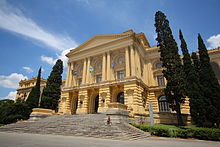 Ipiranga Museum, "Museu do Ipiranga."
Ipiranga Museum, "Museu do Ipiranga."
- Museu Paulista
Also popularly known as "Ipiranga Museum", the first monument especially built to preserve the memory of the Independence of Brazil, opened on September 7, 1895, with the name of Museu de Ciências Naturais (Natural Science Museum). In 1919, it became once again a historic museum. Having the architectural influence of the Versailles Palace in France, the Ipiranga's collection, with approximately 100,000 pieces, comprises works of art, furniture, clothing, and appliances that once belonged to famous people who took part in Brazilian history, such as explorers, rulers, and freedom fighters. Its facilities are also home to a library with 100,000 books and the "Centro de Documentação Histórica," Historic Documentation Center, with 40,000 manuscripts.
- Memorial da América Latina
Stretching over 78,000 square meters, Memorial da América Latina (Latin America's Memorial) was conceived to be a place for the integration of Latin American countries and their roots and cultures. Memorial is home to the headquarters of Parlamento Latino-Americano – Parlatino (Latin American Parliament). Designed by the architect Oscar Niemeyer, Memorial has an exhibition pavilion, where there is a permanent exhibition of the continent's craftwork production; a library with books, newspapers, magazines, videos, films and records about the history of Latin America; and an auditorium with capacity for 1,679 people.
- Museu da Imigração e Memorial do Imigrante
Memorial of the Immigrant, "Memorial do Imigrante."
Hospedaria do Imigrante (Immigrant's Hostel) was built in 1886 and opened in 1887, when the first immigrants were housed there. The Immigrant's Hostel was built in Brás to welcome the immigrants who arrived in Brazil through the Port of Santos, quarantining those who were sick and helping new arrivals to find work in coffee plantations in Western, Northern, and Southwestern São Paulo State and Northern Paraná State. From 1882 to 1978, 2.5 million immigrants of more than 60 nationalities and ethnicities were guests there,[88] all of them duly registered in the museum's books and lists. The hostel used to serve approximately 3,000 people on average, but under special circumstances, this number reached 8,000. The hostel received the last immigrants in 1978.[89]
In 1998 the Hostel became a museum, and it preserves the documentation, memory and objects of the immigrants that came to Brazil in search of hope and wealth. Located in one of the few centenarian buildings left in the city of São Paulo, the museum occupies part of the former Hostel. Aside from bringing the immigrants' history to the public, the museum also restores wooden train wagons from the former São Paulo Railway. There are two restored wagons in the museum. One of them dates from 1914, and another one a second class passenger car, dates from 1931. The Memorial do Imigrante pays homage to the ancestors of millions of Brazilians who arrived through the port of Santos and had São Paulo as a gateway to Brazil. It is possible to find in the museum the names of all immigrants who were hosted there from 1888 to 1978.[90]
- Museu de Zoologia da USP
Occupying an area of 700 square meters, the animals shown in the museum are samples of the country's tropical fauna and were prepared (embalmed) more than 50 years ago. In the entrance hall, there is information about the main activities carried out by USP's staff and by the museum's researchers. The animals are grouped together according to their classification: fish, amphibians, reptiles, birds and mammals, and some invertebrates such as reefs, crustaceans and mollusks. The library, specialized in zoology, has modern facilities and equipment and serve both the scientific community and the public in general. It has 73,850 works, of which 8,473 are books and 2,364 are newspapers, in addition to theses and maps.
- Museu de Arte de São Paulo
The museum was founded by the journalist Assis Chateaubriand and directed by Pietro Maria Bardi. Its current headquarters, opened in 1968, were designed by the architect Lina Bo Bardi. Two enormous colonnades support the 9,2 thousand ton building, forming a 74-meter free space, unique in the world. MASP has one of world's most important collections of European art,the most important collections are about Italian and French painting schools, but there are including works of art by distinguished artists of others European schools, such as Degas, Renoir, Modigliani and Bonnard, among others, The collection contains over 9,000 works of art's masterpieces of inestimable value,.
- Acervo do Palácio dos Bandeirantes
The headquarters of the State Government has an important collection of works of art by Brazilian artists, such as Portinari, Aldo Bonadei, Djanira, Almeida Júnior, Victor Brecheret, Ernesto de Fiori and Aleijadinho. Additionally, it also gathers colonial furniture, leather and silver artefacts, and European tapestry. In eclectic style, its walls are covered with panels describing the history of São Paulo.
- Museu da Imagem e do Som
Opened in May 1990, the main aim of Museu da Imagem e do Som (Image and Sound Museum) is to keep and preserve manifestations in the music, cinema, photography, and graphical arts areas, as well as any other manifestation related to the Brazilian contemporary life. MIS has a collection of more than 200,000 images, distributed in thematic collections of diverse content. It has more than 1,600 fiction videotapes, documentaries and music, and 12,750 titles recorded in Super 8 and 16 mm. Additionally, MIS organizes concerts, cinema and video festivals, and photography and graphical arts exhibitions.
Tourism and recreation
Main article: Tourism in BrazilIbirapuera Park at night during Christmas.
São Paulo is a major cultural centre. The city has an ethnically diverse metropolitan area, with predominant Italian, Portuguese and African background. It also has a significant number of Spanish, Lebanese and Japanese descendents. São Paulo is known for its varied and sophisticated cuisine, ranging from Chinese to French, from fast food chains to five star restaurants. There are approximately 62 different types of cuisines in São Paulo, and more than 12,000 restaurants.[91] Other venues such as bars, pubs, lounges and discos cater to a variety of music tastes.
São Paulo is home to the São Paulo Museum of Art (MASP), dedicated by Queen Elizabeth II in the first half of the 20th century and "Pinacoteca do Estado" art museums, a symphonic orchestra (São Paulo State Symphony (OSESP – based in the Sala São Paulo theatre in the gorgeous Julio Prestes train station)), and a Formula One Grand Prix racing circuit (Interlagos).
Landmarks
- Paulista Avenue (one of the most important thoroughfares of the city and the site of many cultural centers and museums, such as the MASP and Centro Cultural Itaú).
- Brooklin (a financial and residential district).
- Banespa Building (skyscraper with observation deck and museum designed after the Empire State building).
- Catedral da Sé (the metropolitan cathedral, a symbol of the city).
- Edifício Copan, designed by Oscar Niemeyer, in the Centro neighbourhood. Built between 1951 and 1966, its wavy shape gives the building an impression of movement, and the integration of small businesses and residential flats are of innovative urbanism.
- Edifício Itália (skyscraper with observation deck).
- Estação da Luz (historical railway station built 1895–1901).
- Mooca (Italian district of São Paulo).
- Liberdade (Asian district of São Paulo).
- Mercado Municipal (historical market place in São Paulo).
- Municipal Theatre of São Paulo (magnificent opera house built in the early 20th century.)
- Museu de Arte Sacra (museum of religious art located in a colonial convent).
- Museu do Ipiranga (museum built where the Independence of Brazil was proclaimed in 1822).
- Museum of the Portuguese Language (located inside Estação da Luz).
- Pátio do Colégio (founding site of the city, former Jesuit mission-school to convert the natives to Catholicism).
- Pinacoteca do Estado de São Paulo (important museum of Brazilian art).
- Praça da Sé (large square next to the São Paulo Cathedral. Official centre of the city).
Parks
There are several parks in the city of São Paulo:
- Parque da Aclimação - Located in the Aclimação neighbourhood in the central region, it was inaugurated in 1939 and has an area of approximatelly 112,000 m2 (1,205,558 sq ft).
- Parque da Água Branca - Located at the west side of the city, in the Barra Funda district. It was inaugurated in 1929 and has an area of approximately 136,000 m2 (1,463,892 sq ft).
- Parque Alfredo Volpi - With an area of 142,000 m2 (1,528,475 sq ft), it's located at the south side of the city, in the Cidade Jardim neighbourhood.
- Parque Anália Franco - Located in the Jardim Anália Franco neighbourhood, has an area of 286,000 m2 (3,078,478 sq ft).
- Parque Anhanguera - This park features native Atlantic Forest and is environmentally protected by law. Because of that, most of its area has restricted access. It was inaugurated in 1979 and has an area of approximately 9,000,000 m2 (96,875,194 sq ft). Located in the Perus neighbourhood, it's situated close to the Jaraguá peak, in the city's far northwest.
- Parque Buenos Aires - Located in the Higienópolis neighbourhood, in the city's central area. It was inaugurated in 1913 and has an area of 22,200 m2 (238,959 sq ft).
- Parque Burle Marx - Inaugurated in 1995, it's located in the Panamby neighbourhood, in the city's south side.
- Parque da Cantareira - Inaugurated in 1963, it's an environmental protection unit and was listed by UNESCO in 1994. With an area of approximately 7,916.52 hectares, it covers part of the Cantareira mountains, which is part of the Atlantic Forest. Includes areas of the north side of São Paulo and parts of the cities of Mairiporã, Guarulhos and Caieiras.
- Parque do Carmo - Inaugurated in 1976, it's the biggest public park inside the city, with an area of approximately 500,000 m2 (5,381,955 sq ft). Situated at the city's east side, in the Itaquera neighbourhood.
- Parque Cidade de Toronto - Located in the district of Santo Domingo, north-west of the city.
- Parque dos Eucaliptos - Located in western Sao Paulo in the district of Vila Sonia.
- Parque Estadual Fontes do Ipiranga - Also known as Parque do Estado (State Park), it was created in 1991 and extends over 526 hectares. Contains remnants of the Atlantic Forest vegetation.
- Parque Ecológico do Guarapiranga - Situated on the banks of the Guarapiranga reservoir on the south side of the city.
- Parque Guarapiranga - Located on the banks of Guarapiranga Dam, in the district of Campo Limpo (south side of São Paulo).
- Horto Florestal de São Paulo - Located in the northern side of São Paulo, at about seven miles from the center of the city, it occupies an area of 174 hectares at the foot of the Cantareira mountains. It's adjacent to the Cantareira State Park in the district of Mandaqui. It's access can be made from the neighboring district of Tremembé, and its accecible perimeter is 47,875 meters.
- Ibirapuera Park - The second largest park of the city and probably the most popular. It's home to several museums and is known for its buildings designed by Brazilian architect Oscar Niemeyer, such as the Oca and the new Ibirapuera Auditorium.
- Parque Estadual do Jaraguá - Created in 1961, around the Jaraguá peak.
- Parque Jardim Felicidade - Located in the Pirituba district, north side of the city.
- Parque Luís Carlos Prestes - A small park located in the extreme west of São Paulo, in the Jardim Rolinópolis neighbourhood, near the Raposo Tavares highway and close to another city park, the Parque da Previdência. Opened in 1990, it was named after the political, military and revolutionary Luis Carlos Prestes, and has an area of 27,100 m2 (291,702 sq ft).
- Parque Nabuco - Located in the Jabaquara district, south side of the city.
- Parque do Piqueri - Located in the Tatuapé neighbourhood, has an area of 97,272 m2 (1,047,027 sq ft).
- Parque Previdência - Located in the far west of São Paulo in the neighborhood of Jardim Rolinópolis, near the Raposo Tavares highway. It has an area of 91,500 m2 (984,898 sq ft) and was founded in 1979.
- Parque Lina e Paulo Raia - Located in the Jabaquara district, southern Sao Paulo, has an area of 15,000 m2 (161,459 sq ft).
- Parque Raposo Tavares - Located on the western outskirts of the city, in the district of Butantan.
- Parque Raul Seixas - It has 33,000 m2 (355,209 sq ft) and is situated in the district of Itaquera, in the East of the city.
- Parque Rodrigo de Gásperi - Located in the Pirituba district, north side of the city.
- Parque Santa Amélia - Located in the Itaim Paulista district, eastern suburb of São Paulo.
- Parque Santo Dias - Located in the district of Capão Redondo, in the city's south side suburb.
- Parque São Domingos - Located in the district of Santo Domingo, west of the city. It was named after the neighborhood, which honors the Catholic saint Dominic Savio.
- Parque Severo Gomes - Located in the neighborhood of Granja Julieta, south of the city, was inaugurated in 1989.
- Parque Ecológico do Tietê - With an area of 12.5 million m², inaugurated in 1982, it's an environmental protection region. Located in the floodplain of the Tietê River, between the cities of São Paulo, Guarulhos Itaquaquecetuba.
- Parque Trianon - Inaugurateded in 1892 with the opening of Paulista Avenue, it was designed by French landscape architect Paul Villon. The name came from the fact that at that time, opposite the park, there was a club named Trianon. In 1924 it was donated to the city, and in 1931 received its current name in honor of one of the heroes of the Uprising Lieutenants, Antonio de Siqueira Campos.
- Parque Vila dos Remédios - Located in the district of Jaguara, close to the confluence of the Pinheiros and Tietê rivers in the city's north side.
- Parque Vila Guilherme - Opened in 1986, it's ocated in the district of Vila Guilherme, north side of the city.
- Parque Ecológico da Vila Prudente - Located in the district of VilaPrudente, on the city's east side.
- Parque Villa-Lobos - Opened in 1994, it's located in the Alto de Pinheiros district, on the banks of the Pinheiros River, and has an area of 732,000 m2 (7,879,182 sq ft).
Zoos
The Zoological Park of São Paulo is the largest in Brazil. Located in an area of 824,529 m2 (8,875,156 sq ft) of original Atlantic Forest, has approximatelly 4 miles of alleys. It houses the headwaters of the historic stream of Ipiranga, at south side of the city. Displays more than 3,200 animals, 102 species of mammals, 216 species of birds, 95 species of reptiles, 15 species of amphibians and 16 species of invertebrates, in enclosures that replicate the natural habitats of these animals. The Zoo's farm of 572 ha, produces vegetables used in the manufacture of feed for various animals, and material to the enclosures where the animals stay. There are animals that need extra area for mating.
The zoo also counts with a nursery for rejected puppies and incubators for hatching eggs of birds and reptiles. His library of more than four thousand volumes is open to the public. Its partnerships with other state, federal and foreign research institutions include researches that aim to facilitate the preservation of endangered species.
São Paulo also has a Safari Zoo located in its southeastern side, in the district of Cursino.
Aquarium
The Aquário de São Paulo (São Paulo Aquarium) it's one of the largest aquariums in Latin America, with an area of 9,000 square meters and 2 million liters of water. It has approximately 3,000 copies of about 300 species of animals, and it's located in the Ipiranga neighbourhood.
Sports
See also: 2014 FIFA World Cup and Sports in BrazilFootball
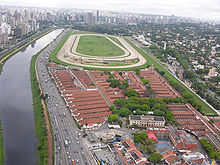 Aerial Photography of Jockey Club de Sao Paulo.
Aerial Photography of Jockey Club de Sao Paulo.
As in the rest of Brazil, Association football is by far the most popular sport in the city. The major teams in São Paulo are known as "The Iron Trio" ("Trio de Ferro"): Corinthians, Palmeiras and São Paulo FC. There are three other small clubs in the city, Portuguesa, Juventus and Nacional.
São Paulo is one of the host cities of the 2014 FIFA World Cup, for which Brazil is the host nation. The opening of 2014 FIFA World Cup, is under negotiation to be held in the Corinthians stadium, called Arena Itaquera, which is being built.
Football/soccer teams Club League Venue Established SC Corinthians Série A Alfredo Schürig Stadium 16,000 (28,000 record)
1910 SE Palmeiras Série A Palestra Itália Stadium 29,173 (40,283 record)
1914 São Paulo FC Série A Morumbi Stadium 67,428 (138,032 record)[92]
1935 Portuguesa Série B Canindé Stadium 19,717 (25,000 record)
1920 Juventus Campeonato Paulista Série A3 Rua Javari Stadium 2,730 (9,000 record)
1924 Nacional Campeonato Paulista Série A2 Nicolau Alayon Stadium 9,650 (22,000 record)
1919 São Silvestre Road Race
Main article: Saint Silvester Road RaceThe São Silvestre Race takes place every New Year's Eve. It was first held in 1925, when the competitors ran about 8,000 metres across the streets. Since then, the distance raced varied, but is now set at 15 km (9.3 mi).
Brazilian Grand Prix
The Formula One Brazilian Grand Prix (Portuguese: Grande Prêmio do Brasil) is held at the Autódromo José Carlos Pace in Interlagos, a neighborhood of São Paulo. The race at Interlagos has been held continuously since 1990. Since 1973, the first year Formula One Grand Prix had been held in Brazil, 4 Brazilians have won the Grand Prix in São Paulo: Emerson Fittipaldi (1973 and 1974), José Carlos Pace (1975), Ayrton Senna (1991 and 1993) and Felipe Massa (2006 and 2008).
In 2007, new local railway station Autódromo of the Line C (Line 9) of CPTM, was constructed near the circuit to improve access.
São Paulo profits the most in the year during the F1 Brazilian Grand Prix due to boosts in tourism, commerce and nightlife.
São Paulo Indy 300
The 2010 São Paulo Indy 300 was the first race of the 2010 IZOD IndyCar Series season. This 190.2-mile (306.1 km) race took place on March 14, on the 2.536-mile (4.081 km) temporary street circuit in São Paulo, Brazil. The race was telecasted by Versus.
There are seven IndyCar drivers from Brazil competing in the series, including Ana Beatriz, Hélio Castroneves, Tony Kanaan, Raphael Matos, Vitor Meira, Mario Moraes and Mario Romancini. São Paulo is the hometown of Beatriz, Castroneves, Moraes and Romancini.
Other sports
Volleyball, basketball and tennis are other major sports. There are several traditional sports clubs in São Paulo that are home for teams in many championships. The most important are Esporte Clube Pinheiros (waterpolo, volleyball, swimming, basketball and handball), Clube Atlhetico Paulistano (basketball), Esporte Clube Banespa (volleyball, handball and futsal), Esporte Clube Sírio (basketball), Associação Atlética Hebraica (basketball), São Paulo Athletic Club (rugby union), Pasteur Athlétique Club (rugby union), Clube de Regatas Tietê and Clube Atlético Ipiranga, also, on Bom Retiro, we have the Baseball Stadium, Mie Nishi.
International sports events
The following international sports events have been held in São Paulo:
- 1950 – FIFA World Cup (association football);
- 1963 – Pan American Games (Multi-sports);
- 1971 – FIBA World Championship for Women;
- 1977 – Women's U20 Volleyball World Championship;
- 1983 – FIBA World Championship for Women;
- 1993 – Volleyball World League;
- 1994 – Women's Volleyball World Championship;
- 2000 – FIFA Club World Championship (Football);
- 2002 – South American Games (Multi-sports);
- 2005 – World Cup in Artistic Gymnastics;
- 2006 – International Police and Fire Games (Multi-sports);
- 2006 – FIBA World Championship for Women (Basketball);
- 2006 – 13th World Cup Final in Artistic Gymnastics;
- 2007 – 3rd International Blind Sports Association World Championships and Games;
- 2014 – FIFA World Cup (association football).
Transportation
Main articles: Transport in São Paulo and Transport in BrazilHighways
Imigrantes highway connects the city to the ocean coast.
The city is crossed by 10 major Brazilian motorways and automobiles are still the main means to get into the city. They are:
- Rodovia Presidente Dutra/BR-116 (President Dutra highway) – Connects São Paulo to the east and north-east of the country. Most important connection: Rio de Janeiro.
- Rodovia Régis Bittencourt/BR-116 (Régis Bittencourt highway) – Connects São Paulo to the south of the country. Most important connections: Curitiba and Porto Alegre.
- Rodovia Fernão Dias/BR-381 (Fernão Dias highway) – Connects São Paulo to the north of the country. Most important connection: Belo Horizonte.
- Rodovia Anchieta/SP-150 (Anchieta Priest highway) – Connects São Paulo to the ocean coast. Mainly used for cargo transportation to Santos Port. Most important connection: Santos.
- Rodovia dos Imigrantes/SP-150 (Immigrants highway) – Connects São Paulo to the ocean coast. Mainly used for tourism. Most important connections: Santos, São Vicente, Guarujá and Praia Grande.
- Rodovia Castelo Branco/SP-280 (President Castelo Branco highway) – Connects São Paulo to the west and north-west of the country. Most important connections: Osasco, Sorocaba, Bauru, Jaú and Campo Grande.
- Rodovia Raposo Tavares/SP-270 (Raposo Tavares highway) – Connects São Paulo to the west of the country. Most important connections: Cotia, Sorocaba, Presidente Prudente.
- Rodovia Anhangüera/SP-330 (Anhanguera highway) – Connects São Paulo to the north-west of the country, including its capital city. Most important connections: Campinas, Ribeirão Preto and Brasília.
- Rodovia dos Bandeirantes/SP-348 (Bandeirantes highway) – Connects São Paulo to the north-west of the country. It is considered the best motorway of Brazil. Most important connections: Campinas, Ribeirão Preto, Piracicaba and São José do Rio Preto.
- Rodovia Ayrton Senna/SP-70 (Ayrton Senna highway) – Named after Brazilian Formula One pilot Ayrton Senna, this motorway connects São Paulo to east locations of the state, as well as the north coast of the state. Most important connections: São Paulo-Guarulhos International Airport, São José dos Campos and Caraguatatuba.
Rodoanel
Main article: Rodoanel Mário CovasSão Paulo grew quickly from the 1940s to the 1980s and many roads and buildings were built without major planning. As a result, heavy traffic is common on the city's main avenues, and traffic jams are relatively common on its largest highways. The main means of commuting into the city is by car and by bus. In March 2011, there are more 7 million vehicles registered.[93] An effective way of avoiding heavy vehicles traffic in the city, such as buses and trucks that crossed the city for other destinations, was planned by ex-governor Mário Covas as a road ring that circles the city, called Rodoanel Mario Covas,[94] and is being built by DERSA.[95]
Railways
Main article: Rail transport in Brazil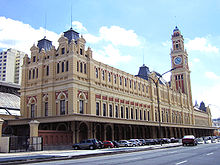 Luz Station "Estação da Luz" in the morning.
Luz Station "Estação da Luz" in the morning.
The two major São Paulo train stations are Luz and Julio Prestes in the Luz/Campos Eliseos region. Luz is the seat of the Santos-Jundiaí line which historically transported international immigrants from the Santos port to São Paulo and the coffee plantation lands in the Western region of Campinas. Julio Prestes connected the SW São Paulo State and Northern Paraná State to São Paulo and products were transferred to Luz Station from which they headed to the Atlantic ocean and overseas. Julio Prestes ceased from transporting passengers through the Sorocabana or FEPASA lines and now only has limited suburban service. Due to its acoustics and the beauty of its interior, surrounded by Greek revival columns, part of the rebuilt station was transformed into the São Paulo Hall, or Sala São Paulo, home of the internationally, known São Paulo Orchestra.
Luz Station, which was built in Britain and assembled in Brazil, has an underground station and is still very active with east and westbound suburban trains that link São Paulo to the Greater São Paulo region to the East and the Campinas Metropolitan region in Jundiaí in the western part of the State. Besides housing the interactive Museu da Língua Portuguesa (Portuguese Language Museum), Luz Station is surrounded by important cultural institutions such as the Pinacoteca do Estado, The Museu de Arte Sacra on Tiradentes Avenue and Jardim da Luz, among others.
Although poorly maintained by heavy rail services, there is an infrastructure project to build a high-speed railway service linking Brazil's two largest cities, São Paulo and Rio de Janeiro.[96] The trains would go as fast as 280 kilometres per hour (170 mph) (the trip would last about 1 hour and 30 minutes). This specific project is still waiting an official announcement by the Brazilian government, who is trying to obtain international financing through a public-private partnership.
Another important project is the "Expresso Bandeirantes," which is a medium-speed rail service (about 160 km/h) from São Paulo to Campinas, which would reduce the journey time from the current one hour and a half by car to about 50 minutes by train, linking the towns of São Paulo, Jundiaí, Campinas Airport, and Campinas city center. This service is also going to be connected to the railway service between São Paulo city center and Guarulhos Airport. Major works on an express railway service between São Paulo city center and Guarulhos International Airport were announced by the São Paulo state government in 2007,[97] which will be a milestone in the revitalisation and improvement of the Brazilian passenger railway services.
Airports
 Congonhas Airport. Airplanes waiting in line to take off due to congestion at Congonhas airport.
Congonhas Airport. Airplanes waiting in line to take off due to congestion at Congonhas airport.
São Paulo has two main airports. The São Paulo-Guarulhos International Airport (IATA: GRU) for the international flights and the Congonhas-São Paulo Airport (IATA: CGH) for domestic and regional flights. Another airport, the Campo de Marte Airport, serves light aircraft and helicopters. The three airports together moved 42,617,779 passengers in 2010, making São Paulo one of the top 30 busiest in the world, by number of air passenger movements. The region of Greater São Paulo is also served by São José dos Campos Airport and Viracopos-Campinas International Airport.
Congonhas Airport operates flights mainly to Rio de Janeiro, Belo Horizonte and Brasília. After the upgrade work by Infraero has been completed, passengers now enjoy new boarding lounges, located on the mezzanine level, accessed by escalators. Besides this, eight boarding bridges were installed to provide more comfort to passengers by eliminating the need to walk in the open to their flights.
The terminal area was expanded from 37.3 thousand to over 51 thousand square meters. This expansion did not seek to raise capacity, which was already saturated, but only to satisfy current demand. Congonhas Airport, built in the 1930s, was designed to handle 6 million passengers a year and was operating with 12 million a year. The ample new boarding area, separated from the main concourse, adds greatly to passenger comfort.[99]
Panoramic photo of Campo de Marte Airport and in the background the Skyline of the district of Santana
Campo de Marte is located in Santana district, the northern zone of São Paulo. The airport handles small aircraft, particularly private craft belonging to flying clubs and air taxi firms. Opened in 1935, Campo de Marte today is the base for the largest helicopter fleet in Brazil. It has no scheduled airlines, but its terminal is equipped with a snack bar, restaurant and bank branch. This airport also is the home base of the State Civil Police Air Tactical Unit, the State Military Police Radio Patrol Unit and the São Paulo Flying Club.[100]
A city with possibly the world's highest helicopter ownership rate. Largely using this airport, an elite wealthy class takes advantage of some one hundred remote helipads and heliports to conveniently bypass heavy road traffic.[101] Campo de Marte also hosts the Ventura Goodyear Blimp.
The Guarulhos International, also known to São Paulo dwellers as "Cumbica" is 25 km (16 mi) north-east of the city center, in the neighbouring city of Guarulhos. Every day nearly 100 thousand people pass through the airport, which connects Brazil to 28 countries around the world. There are 370 companies established there generating 53 thousand employments. With capacity to serve 15 million passengers a year, in two terminals, the airport currently handles 12 million users.
Construction of a third passenger terminal is pending, to raise yearly capacity to more than 45 million passengers. The project, in the tendering phase, is part of the airport’s master plan and will get under way shortly. São Paulo International Airport is also the main air cargo hubs in Brazil. The roughly 100 flights a day carry everything from fruits grown in the São Francisco Valley in the Northeast to the most sophisticated medications created by science in the Southeast. The airport's cargo terminal is South America's largest and stands behind only Mexico City's in all of Latin America. In 2003, over 75 thousand metric tons of freight passed through the terminal.[102]
Metro
Main articles: São Paulo Metro and Companhia Paulista de Trens MetropolitanosThe city has actually 379,7 km, operated by three companies, the first is 69.0 km (42.9 mi) of underground railway systems (34.6 km (21.4) fully underground) (the São Paulo Metro,[103] locally known as the Metrô), with 5 lines in operation and 59 stations,but at this moment other stations and extensions of two line are in work, thisis complemented by another 260.7 km (162.0 mi) of Companhia Paulista de Trens Metropolitanos (CPTM, or "Paulista Company of Metropolitan Trains") railways, the third one is Via4. Both CPTM, Via4 and Metrô, so the underground and railway lines carry some 7 million people on an average weekday, and new underground lines to be constructed are expected to add another million people to the system within the next five years. The projects expected to expand São Paulo's urban railway system from the current 322 km (200 mi) to more than 500 km (310 mi) on the next 10 years, surpassing the London Underground.[104]
São Paulo has three rapid transport systems:
- The underground rail system (called "metrô", short for "metropolitano" and in plates in English is called "subway"), with three complete lines.
- The suburban rail system, Companhia Paulista de Trens Metropolitanos (CPTM), has six lines that serve many regions not reached by the underground system, and even some other cities in the metropolitan region. The CPTM network is longer than the underground rail system.
- The fast-lane bus system: there are many such bus lines in the city, called "Passa Rápido," which are street-level, placed on large avenues, and connected with the underground or suburban train stations.
Further information: Expresso TiradentesSão Paulo has no tram lines, although trams used to be common in the first half of the 20th century.[105] São Paulo's underground train system is considered modern, safe and clean and, although it still has some problems with overcrowding, it was considered one of the best subway systems, as certified by the NBR ISO 9001. It has five lines and links to the metropolitan train network, the CPTM. The São Paulo Metro last year reached the mark of 11.5 million passengers every mile of line. The number is 15% higher than in 2008, when 10 million users were taken per mile. It is the largest concentration of people in a single transport system in the world, according to the company.
Also in 2008, the Moscow metro, in Russia, moved 8.6 million people for every mile of track. The Shanghai, China, took 7 million, according to the Community of Metros (Comet, English acronym), an organization that brings together representatives of the 12 largest metro systems in the world. Data from last year have not been released by Comet.
Every day last year, 2.56 million people passed through the turnstiles of the subway capital, on average. If taken into account transshipments, these passengers have about 3.5 million trips per day, according to balance sheet contained in the "Management Report 2010" released yesterday with the company's balance sheet. The number of entries in the stations was 6.8% higher than recorded in 2009.
While the total number of passengers has increased the satisfaction of those who use the system decreased. The survey "The Metro according to its user: a service evaluation" of last year showed that 60% of respondents rated the means of transport as "very good" and "good." In 2009, the notes were 67% positive. The survey is conducted since 1974.
Buses
Main article: Trolleybuses in São PauloThe bulk of the public transport (government and private companies) is composed of approximately 17,000 buses (including about 290 trolley buses),[106] coloured uniformly according to the non-central region served (ex.: light green for the buses that go North West, dark blue for the Northern area). Until the past few years, there was a strong presence of informal transport vans (dab vans), but the vast majority of such vans are already fully registered with the city council, legalized and operating under the same color scheme of the main system.
São Paulo Tietê Bus Terminal is the second largest bus terminal in the world. It serves localities in all the States of Brazil, with the exception of Amazonas, Roraima and Amapá. There are routes to 1,010 cities in five countries (Brazil, Argentina, Chile, Uruguay, and Paraguay). It offers a special line to the Congonhas and Guarulhos airports, and a ride sharing automobile service to Santos.
The Palmeiras-Barra Funda Intermodal Terminal is much smaller and is connected to the Palmeiras-Barra Funda metro and Palmeiras-Barra Funda CPTM stations. It serves the southwestern cities of Sorocaba, Itapetininga, Itu, Botucatu, Bauru, Marília, Jaú, Avaré, Piraju, Santa Cruz do Rio Pardo, Ipaussu, Chavantes, and Ourinhos (on the border with Paraná State). It also serves São José do Rio Preto, Araçatuba and other small towns located on the northwest of São Paulo State.
For buses to São Paulo coast, travelers need to get off at the Jabaquara metro station, which is the final southbound stop on Line 1 (Blue) of the São Paulo Metro. The Litoral bus terminal serves Praia Grande, Santos and São Vicente on the South Shore and Mongaguá, Bertioga, and Guarujá on the North Shore. Buses to North Shore cities such as Maresia, Riviera de São Lourenço, Caraguatatuba, Ubatuba, and Paraty, in Rio de Janeiro State must be taken at the Tietê Bus Terminal, at Portuguesa-Tietê metro station on Line 1 (Blue).
Helicopters
Due to the intense traffic jams on the roads combined with fears of kidnappings among its richer citizens, São Paulo has become the city with the highest number of helicopters in the world. With 462 private helicopters[108] in 2008, and around 70,000 flights per year within central São Paulo, according to the British newspaper The Guardian, is turning into a "real life South-American episode" of The Jetsons.[109]
Helicopters enable businessmen and other executives to sharply reduce their commuting time, at least to the most important meetings and conferences. They are also used to bring executives in from their homes in distant parts of the greater metropolitan area and back to them at the end of the work week. Some companies own their helicopters, others lease them, and still others use helicopter taxi services. One suburban helicopter shuttle service, located about 15 miles (24 km) from the center of the city in a suburb called Tamboré, is unique in the sense that it is run and operated totally by women, including its pilots.
Current critical problems
Traffic congestion on Consolação Street Main articles: Crime in Brazil and Social issues in Brazil
Main articles: Crime in Brazil and Social issues in BrazilCrime in São Paulo was a constant issue. For two decades, São Paulo's murder rate was consistently higher than the average for Brazil. The murder rate in São Paulo fell below the average rate for Brazil in 2004.[110] The city made strides in gun control, and the local police raised the homicide solving rate from 8 percent to 70 percent from the 1990s to 2008.[110]
Since the beginning of the 20th century, São Paulo has been a major economic center in Latin America. With the arrival of the two World Wars and the Great Depression, coffee exports (from other regions of the state) to the United States and Europe were critically affected, leading wealthy coffee farmers to invest in industrial activities which eventually turned São Paulo into Brazil's largest industrial hub. The new job positions thereof contributed to attracting a significant number of immigrants from Europe and Asia and migrants from within the country, especially the northeastern states. From a population of merely 32,000 inhabitants in 1880, São Paulo increased its population to approximately 250,000 in 1900, 1,800,000 in 1940, 4,750,000 in 1960 and 8,500,000 in 1980. The effects of this population boom have been:
- Poverty and development of favelas
- Although urban planning has been implemented in some areas, São Paulo has developed quickly without major planning.
- Overcrowded public transport associated with a high number of cars and other vehicles in circulation lead to consistently congested traffic on many roads of the city.
- Due to heavy usage and poor maintenance, the quality of the pavement on certain roads (especially in the outskirts of the city) is problematic, and potholes and other asphalt defects are common.
- For a long time considered to be one of the most critical problems found in the city, crime rates are, finally, about to reach acceptable levels, according to the UN parameters of violence, with its numbers consistently decreasing for the past 8 years.[111] The number of murders state-wide in 2007 was 67% lower than it was in 2000,[112] one-quarter of that in the State of Rio de Janeiro.[113]
- High air pollution,[114] mainly due to the high circulation of automobiles and buses in town.
- The two major rivers crossing the city, Tietê and Pinheiros, are highly polluted. A major project to clean up these rivers is under way.
Solutions
- The Clean City Law or antibillboard, approved in 2007, focused on two main targets: antipublicity and anticommerce. Advertisers estimate that they removed 15,000 billboards and that more than 1,600 signs and 1,300 towering metal panels were dismantled by authorities.[115]
- Some countries have adopted vehicular restrictions in order to reduce air pollution levels. In São Paulo metropolitan region, the vehicle restriction was adopted from 1996 to 1998, in order to reduce air pollution, during wintertime. Since 1997, a similar project was implemented during the whole year in the central area of São Paulo in order to improve the urban traffic.[116]
Human development
 Map of the districts of São Paulo by human development index.
Map of the districts of São Paulo by human development index.
In 2007 the city of São Paulo conducted a survey about the quality of life of its inhabitants to help the government in the framing of social policy.[citation needed] The indicator used was the HDI – the same used by the UN for qualifying the development of the countries in the world.
It was noted in this survey that the neighborhoods around or in the geographical center of the city tend to be more developed than those located in the fringes. In 2000, top neighborhoods possessed human development indexes equal to or greater than those of Scandinavian countries, while neighborhoods in the lower range were in line with, for example, North Africa.
Top districts
- Moema (0.961) – (Equal to
 Canada – 0.961)
Canada – 0.961) - Pinheiros (0.960) – (Equal to
 Ireland – 0.960)
Ireland – 0.960) - Jardim Paulista (0.957) – (Greater than
 Sweden – 0.956)
Sweden – 0.956) - Itaim Bibi (0.953) – (Equal to
 Japan,
Japan,  Netherlands – 0.953)
Netherlands – 0.953)
Districts in last 5 places
- Marsilac (0.701) – (In line with
 Mongolia – 0.700)
Mongolia – 0.700) - Parelheiros (0.747) – (In line with
 Azerbaijan – 0.746)
Azerbaijan – 0.746) - Lajeado (0.748) – (In line with
 Azerbaijan – 0.746)
Azerbaijan – 0.746) - Jardim Ângela (0.750) – (In line with
 Guyana – 0.750)
Guyana – 0.750) - Iguatemi (0.751) – (In line with
 Guyana – 0.750)
Guyana – 0.750)
Twin towns – sister cities
Main article: Sister cities of São PauloSee also: List of twin towns and sister cities in BrazilSão Paulo is twinned with:[117]
Americas Europe Asia Africa 
Buenos Aires, Argentina 
Paris, France[118] 
Yerevan, Armenia 
Luanda, Angola 
La Paz, Bolivia 
Coimbra, Portugal 
Beijing, China[119] 
Bamako, Mali 
Toronto, Canada 
Milan, Italy[120] 
Seoul, South Korea[121] 
Mexico City, México 
Funchal, Portugal 
Tel Aviv, Israel[122] 
Chicago, United States 
Lisbon, Portugal 
Amman, Jordan 
Asunción, Paraguay 
Porto, Portugal 
Damascus, Syria 
Montevideo, Uruguay 
Bucharest, Romania 
Osaka, Japan[123] 
Lima, Peru 
Cluj-Napoca, Romania 
Ningbo, China 
Mendoza, Argentina 
Barcelona, Spain[124] 
Macau, China 
Córdoba, Spain[125] 
New Delhi, India 
Santiago de Compostela, Spain 
Naha, Japan[126] See also
- ABCD Region
- Large Cities Climate Leadership Group
- Largest cities in the Americas
- List of municipalities in the state of São Paulo by population
- São Paulo Turismo S/A – Official Tourism Board of the City of São Paulo
- OPENCities
References
Bibliography
- Lawrence, Rachel (January 2010). Alyse Dar. ed. Brazil (Seventh ed.). Apa Publications GmbH & Co. / Discovery Channel. pp. 183–204.
Notes
- ^ Censo 2010: população do Brasil é de 190.732.694 pessoas
- ^ São Paulo beats more than 20 million inhabitants
- ^ www.lboro.ac.uk The World According to GaWC 2008 – Retrieved on July 6, 2009
- ^ [1] Estadão – The second largest stock exchange
- ^ "E São Paulo". Navios De Guerra Brasileiros. Brazilian Navy. Archived from the original on July 3, 2008. http://web.archive.org/web/20080703230813/http://www.naval.com.br/NGB/S/S031/S031.htm. Retrieved May 3, 2009.
- ^ "São Paulo holds Gay Pride parade," BBC
- ^ a b c Rachel Lawrence: 2010, Page 183
- ^ "Pico do Jaraguá Mountain Official Website". Picodojaragua.com.br. http://www.picodojaragua.com.br/. Retrieved April 17, 2010.
- ^ Brazilian Departamento de Águas e Energia Elétrica, "International Competitive Bidding Tender Announcement"[dead link]
- ^ "Climatic classification in São Paulo State". Instituto Agronômico de Campinas. http://www.scielo.br/pdf/brag/v66n4/22.pdf. Retrieved October 25, 2011.
- ^ "São Paulo 40 Graus". Urbanistas.com.br. March 2, 2009. http://urbanistas.com.br/sp/2009/03/02/sao-paulo-40-graus/. Retrieved April 17, 2010.
- ^ "Britannica Online Encyclopedia – Climate of São Paulo". Britannica.com. http://www.britannica.com/EBchecked/topic/701311/Sao-Paulo/261980/From-city-to-metropolis#. Retrieved April 17, 2010.
- ^ Tempo Agora – Somar Meteorologia. "Climate of São Paulo". Tempoagora.uol.com.br. http://tempoagora.uol.com.br/previsaodotempo.html/brasil/climatologia/SaoPaulo-SP/. Retrieved April 17, 2010.[dead link]
- ^ "INMET — Climatologia — Gráficos Climatológicos". INMET. http://www.inmet.gov.br/html/clima.php.
- ^ "Climatological Normals of Sao Paulo". Hong Kong Observatory. http://www.weather.gov.hk/wxinfo/climat/world/eng/s_america/brazil/sao_paulo_e.htm. Retrieved March 19, 2011.
- ^ "World Weather Information Service - Sao Paulo". World Weather Information Service. http://www.worldweather.org/136/c01083.htm. Retrieved March 19, 2011.
- ^ "EMPLASA – Empresa Paulista de Planejamento Metropolitano SA". July 30, 2007. Archived from the original on July 30, 2007. http://web.archive.org/web/20070530135122/http://www.emplasa.sp.gov.br/metropoles/cme.asp. Retrieved January 24, 2011.
- ^ "Neighborhoods in São Paulo". Sp-turismo.com. http://www.sp-turismo.com/bairros-sp.htm. Retrieved April 17, 2010.
- ^ "Subprefectures in São Paulo". Capital.sp.gov.br. http://www.capital.sp.gov.br/portalpmsp/do/orgaos?op=viewForm&coTipoUnidade=13&coEstruturaPaiVertical=92. Retrieved April 17, 2010.
- ^ São Paulo has the most diversity of Brazil
- ^ "Nicolau Pereira De Campos Vergueiro". Orbita.starmedia.com. http://orbita.starmedia.com/~personaltop/Not00001.htm. Retrieved May 6, 2009.
- ^ "Folha Online – Especial – 2005 – São Paulo 451". .folha.uol.com.br. January 24, 2005. http://www1.folha.uol.com.br/folha/especial/2005/saopaulo451/cronologia.shtml. Retrieved May 6, 2009.
- ^ "Latin American Immigration to São Paulo". Projetofabrica.com.br. http://www.projetofabrica.com.br/i-migrantes/imigrantes_sp.htm. Retrieved April 17, 2010.
- ^ a b c d Do Outro Lado do Atlântico – Um Século de Imigração Italiana no Brasil
- ^ I Censo Étnico-Racial da Universidade de São Paulo. Tabela 21.
- ^ Uma inserção dos migrantes nordestinos em São Paulo: o comércio de retalhos
- ^ "Ethnicities of São Paulo". Brasilescola.com. http://www.brasilescola.com/brasil/populacao-etnias-sao-paulo.htm. Retrieved April 17, 2010.
- ^ "Especiais – Agência Brasil". Radiobras.gov.br accessdate=2010-04-17. http://www.radiobras.gov.br/especiais/saopaulo450/sp450_mat10_2004.htm.
- ^ "Especiais – Agência Brasil". Radiobras.gov.br. http://www.radiobras.gov.br/especiais/saopaulo450/sp450_mat13_2004.htm. Retrieved April 17, 2010.[dead link]
- ^ IBGE. Census 2000. População residente por cor ou raça e religião.
- ^ a b c d e f "450 Anos de São Paulo". Colunista.com.br. http://www.colunista.com.br/sp450/index.htm. Retrieved April 17, 2010.
- ^ IBGE. Census 2000. População residente por cor ou raça e religião
- ^ "Programa Saúde da Família atende imigrantes". Etni-cidade. March 24, 2005. http://www.etni-cidade.net/bolivianos_saude.htm. Retrieved April 17, 2010.
- ^ Enciclopédia das Línguas no Brasil. "ELB". Labeurb.unicamp.br. http://www.labeurb.unicamp.br/elb/asiaticas/leiamais_coreano.html. Retrieved April 17, 2010.
- ^ "Portal da Cidadania". Radiobras.gov.br. Archived from the original on June 29, 2008. http://web.archive.org/web/20080629200751/http://www.radiobras.gov.br/especiais/saopaulo450/sp450_mat15_2004.htm. Retrieved May 6, 2009.
- ^ "Barsa Planeta Ltda". Brasil.planetasaber.com. http://brasil.planetasaber.com/default.asp. Retrieved April 17, 2010.
- ^ "Sistema IBGE de Recuperação Automática – SIDRA". Sidra.ibge.gov.br. http://www.sidra.ibge.gov.br/bda/tabela/listabl.asp?z=cd&o=7&i=P&c=2094. Retrieved May 6, 2009.
- ^ "Pelos cantos da cidade: Música popular em São Paulo na passagem do século XIX ao XX" (in Portuguese) (PDF). http://www.revistafenix.pro.br/PDF6/5%20-%20ARTIGO%20-%20AILTONPEREIRA.pdf. Retrieved September 7, 2008.
- ^ "Especial aniversário de São Paulo". Jornal Mercado Paulista. http://www.jornalmercadopaulista.com.br/cultura_jan2006.htm. Retrieved May 6, 2009.
- ^ Teixeira, Tim. "Diário do Comércio – Especiais – Locarno". Nesta festa, a Mooca é mais italiana do que nunca. (at this feast, the Mooca is more Italian than ever (in English)). Archived from the original on March 23, 2008. http://web.archive.org/web/20080323025443/http://www.dcomercio.com.br/especiais/mooca450anos/18.htm. Retrieved January 24, 2011.
- ^ O centenário de Adoniran Barbosa reacende o debate sobre a influência italiana na fala brasileira
- ^ "ELB". Labeurb.unicamp.br. http://www.labeurb.unicamp.br/elb/asiaticas/asiaticas.htm. Retrieved May 6, 2009.
- ^ Germans immigrated to Sao Paulo and helped to form the middle-class
- ^ Russians, Ukrainians, Lithuanians and Poles immigrated to Vila Zelina in São Paulo
- ^ "Departamento Estadual De Trânsito De São Paulo". Detran-Sp. http://www.detran.sp.gov.br/wps/portal/sa-conteudo/5e8c1ee0-9ff1-410c-af1e-d09e22d981d2/!ut/p/b1/vZPJjqMwEIafZR6gmzJgIEcIbnDCFsA04YLIQlgD6SwkPP3QI7U0M5rlMIstH8r6qz77VxWXcDGXHLNbecguZXfMmvc4kVJehGCmIRUghBegZCk4LOQBKJ4E668FBoqma9tn_gp0gDn8Wf4S_S7_lYurNdLmB7vQSeSJaGlDR6978ZHErCqRszyFjiWPcrjK4_zm5ZVypll0rXm5UGLNtG4FDIYl7w67SnuiRtOHmRguxZkLfDw_SEYD9bjPt31ks5WvnMJYCobw8bp0xKKk_Xbb-mys0kUrz7tWeIslz1jnzduTcvL4gXj0ze2mNybffuMHLv1S8G7DFwH8ZKnArSeBnAofFdyAqJNTDJvzlYbgReRCLgYxDapHT8d69KvRdy7swIcEEFiRHYwec6YgcBIn1B0bMbifyYDs-nS_6Jpt7yxvF_lMU3WdIan5HgiWhCagqjommgGspP8NxP8a6Oo8BopMfqlFMlIw-uvABZeUm_Z52LbP8KwgJM3wdARZQJIkc1G1ljW9owMhQdqf88zaEXIzj4KK9Q2UUjHf-M4VVcoem0RamJvR9R2lCd7M0hlvardipMPXWHxqQ9V6dfNFMpC7FtxUWropPdTDEDo4usA-ajaXexcS1wC2ZfRGzUHHe6G1q6vOrzdeU4Cp-scmb9JzVGJmAJBzURvWVskq29fqadjYS5z0l4xn5y3MU4arPuzwPYjzI23XZ4pPD7GsZhamWcWPU78X90eLU4HXLgtxgPoT55hdu-f6lrFbT3LnY4vqp8_8scts/dl4/d5/L2dBISEvZ0FBIS9nQSEh/. Retrieved July 22, 2011.
- ^ "Number of Daily Newspapers". Guiademidia.com.br. http://www.guiademidia.com.br/JORNAIS/SAOPAULO/capital.htm. Retrieved April 17, 2010.
- ^ "IBGE Área Territorial Oficial" (in Portuguese). Orcamento e Gestão. http://www.ibge.gov.br/home/geociencias/cartografia/default_territ_area.shtm?c=5. Retrieved April 22, 2008.
- ^ "List of alpha global cities – 2008". Lboro.ac.uk. April 13, 2010. http://www.lboro.ac.uk/gawc/world2008t.html. Retrieved April 17, 2010.
- ^ "Estadão". Estadao.com.br. http://www.estadao.com.br/noticias/cidades,fab-ampliara-controle-de-helicoptero,242303,0.htm. Retrieved April 17, 2010.
- ^ "The largest cities in the world by land area". Citymayors.com. January 6, 2007. http://www.citymayors.com/statistics/largest-cities-area-125.html. Retrieved April 17, 2010.
- ^ "Estatísticas". Infraero. January 18, 2011. http://www.infraero.com.br/images/stories/Estatistica/2010/Dez.pdf. Retrieved February 2, 2011.
- ^ "Emporis". Emporis. June 15, 2009. http://www.emporis.com/en/bu/sk/st/sr/. Retrieved April 17, 2010.
- ^ "The streets the world's most luxurious". Webluxo.com.br. http://www.webluxo.com.br/noticias/2009/oscar_freire_9a_rua_mais_luxuosa_mundo.htm. Retrieved April 17, 2010.
- ^ "São Paulo Metro". Metro.sp.gov.br. http://www.metro.sp.gov.br/. Retrieved April 17, 2010.
- ^ "CPTM". Cptm.sp.gov.br. http://www.cptm.sp.gov.br/e_companhia/cptm.asp. Retrieved April 17, 2010.
- ^ "Centro Comercial Leste Aricanduva". Aricanduva.com.br. http://www.aricanduva.com.br/institucional.php. Retrieved April 17, 2010.
- ^ "Hcfmusp". Hcnet.usp.br. http://www.hcnet.usp.br/instituicao/quem_somos.htm. Retrieved April 17, 2010.
- ^ Claire Obusan. "Billionaires in São Paulo, Forbes". Forbes. http://www.forbes.com/2011/05/17/cities-with-most-billionaires_slide_8.html. Retrieved July 22, 2011.
- ^ "Yahoo! Finance, in Portuguese". Br.pfinance.yahoo.com. http://br.pfinance.yahoo.com/09112009/22/financas-s-atilde-paulo-sera-sexta.html. Retrieved April 17, 2010.
- ^ "PricewaterhouseCoopers, Global city GDP rankings 2008-2025". https://www.ukmediacentre.pwc.com/imagelibrary/downloadMedia.ashx?MediaDetailsID=1562.
- ^ "Richest cities 2009". PricewaterhouseCoopers. http://www.estadao.com.br/noticias/geral,sp-sera-6-cidade-mais-rica-do-mundo-ate-2025-diz-ranking,463359,0.htm. Retrieved November 9, 2009.
- ^ "BBC – Último Segundo – São Paulo será 6ª cidade mais rica do mundo em 2020, diz estudo". Ultimosegundo.ig.com.br. http://www.bbc.co.uk/portuguese/noticias/2009/11/091109_ranking_cidades_price_rw.shtml. Retrieved September 11, 2009.
- ^ "Instituto Brasileiro de Geografia e Estatística". IBGE. 2006. http://www.ibge.gov.br/home/presidencia/noticias/noticia_impressao.php?id_noticia=1288. Retrieved July 21, 2009.
- ^ FERREIRA, João Sette Whitaker; The myth of the global city, doctoral thesis presented to the FAUUSP, 2003.
- ^ Instituto Brasileiro de Geografía e Estatística. (2006) (in Portuguese) (PDF). informal economy. São Paulo, SP, Brasil: IETS. ISBN 85-240-3919-1. http://www.iets.org.br/article.php3?id_article=567. Retrieved January 27, 2008.
- ^ Federal Foreign Office (2011 [last update]). "Auswärtiges Amt - Brazil". auswaertiges-amt.de. http://www.auswaertiges-amt.de/EN/Aussenpolitik/Laender/Laenderinfos/01-Nodes/Brasilien_node.html. Retrieved 19 July 2011.
- ^ Swedish-Brazilian Chamber of Commerce (2011 [last update]). "Overview". swedcham.com.br. http://www.swedcham.com.br/aboutus_Overview.asp?LOCALE=en&. Retrieved 19 July 2011.
- ^ BM&F Bovespa: About us[dead link]
- ^ "Instituto Brasileiro de Geografia e Estatística". IBGE. http://www.ibge.gov.br/home/estatistica/economia/pibmunicipios/2004_2008/. Retrieved June 3, 2011.
- ^ "Worldwide Cost of Living survey 2011 - Top 50 cities: Cost of living ranking". Mercer. 2011-07-12. http://www.mercer.com/costoflivingpr#City_rankings. Retrieved 2011-07-22.
- ^ "SP é a 10ª cidade mais cara do mundo para estrangeiros; RJ é a 12ª" (in Portuguese). UOL Noticias. 2011-07-12. http://economia.uol.com.br/ultimas-noticias/redacao/2011/07/12/sp-e-a-10-cidade-mais-cara-do-mundo-para-estrangeiros-rj-e-a-12.jhtm. Retrieved 2011-07-22.
- ^ "Global 500 June 2011 Market values and prices at June 30, 2009". FT. http://media.ft.com/cms/27fa616e-6c76-11de-a6e6-00144feabdc0.pdf. Retrieved January 22, 2010.
- ^ http://travel.nytimes.com/2006/03/12/travel/12sao.html?pagewanted=all
- ^ Agenda Cultural de São Paulo – Seja Bem-Vindo! (March 23, 2010). "Agenda Cultural". Agendacult.wordpress.com. http://agendacult.wordpress.com/. Retrieved April 17, 2010.
- ^ Universes in Universe – Gerhard Haupt & Pat Binder (December 19, 2004). "South-South orientation in São Paulo Art Bienal". Universes-in-universe.de. http://www.universes-in-universe.de/car/sao-paulo/2004/e-theme.htm. Retrieved April 17, 2010.
- ^ BBC News website, "São Paulo holds Gay Pride parade". Retrieved June 14, 2007.
- ^ Folha Online website, "Parada Gay bate recorde, dizem organizadores". Retrieved June 14, 2007.
- ^ Baker Publishing Group. "March of Jesus in SP". Christianpost.com. http://www.christianpost.com/article/20070608/-march-for-jesus-draws-over-1-million-evangelicals-in-brazil.htm. Retrieved April 17, 2010.
- ^ "Website of FENATRAN (Portuguese)". Fenatran.com.br. http://www.fenatran.com.br/. Retrieved April 17, 2010.
- ^ FILE – Festival Internacional de Linguagem Eletrônica official website.
- ^ "Video Brasil website". Videobrasil.org.br. http://www.videobrasil.org.br/. Retrieved April 17, 2010.
- ^ Webpage Brooklinfest - German Festival in the district Brooklin Paulista
- ^ Festa de Vila Zelina - Russian and East European Festival in the district Vila Zelina
- ^ Universidades de São Paulo
- ^ Datasus. "DATASUS Health Care Statistics". Datasus.gov.br. http://www.datasus.gov.br/. Retrieved April 17, 2010.
- ^ "Hospital do Cancer de São Paulo". Saopaulo.sp.gov.br. http://www.saopaulo.sp.gov.br/spnoticias/lenoticia.php?id=94650. Retrieved April 17, 2010.
- ^ "Movement website". Movement.co.uk. March 18, 2009. http://www.movement.co.uk/. Retrieved April 17, 2010.
- ^ "Hospedaria dos Imigrantes (1885)". Aprenda450anos.com.br. http://www.aprenda450anos.com.br/450anos/vila_metropole/2-2_hospedaria_imigrantes.asp#. Retrieved April 17, 2010.
- ^ Histórico da Hospedaria[dead link]
- ^ Acervo Histórico-Cultural[dead link]
- ^ São Paulo Convention and Visitors Bureau, "City Facts". Retrieved June 5, 2007.
- ^ "Estádio do Morumbi – Cícero Pompeu de Toledo". Pinheiros.com.br. http://www.pinheiros.com.br/city/morumbi/estadio.htm. Retrieved May 6, 2009.
- ^ "A Melting Pot in the southern hemisphere". The Jakarta Post. April 17, 2011. http://www.thejakartapost.com/news/2011/04/17/a-melting-pot-southern-hemisphere.html. Retrieved June 3, 2011.
- ^ Dersa website, "Rodoanel Mário Covas"
- ^ "DERSA official website". http://www.dersa.com.br/.
- ^ Nasdaq website 2007, "Brazil May Take Bids On Rio-To-São Paulo High-Speed Rail Link"
- ^ Secretaria dos Transportes Metropolitanos do Estado de São Paulo "PPP for construction of Guarulhos Airport Express railway"[dead link]. Retrieved June 5, 2007.
- ^ "Anac redistribui autorizações de pouso e decolagem para aeroporto de Congonhas – 25/01/2010 – UOL Notícias – Cotidiano". Noticias.uol.com.br. January 25, 2010. http://noticias.uol.com.br/cotidiano/2010/01/25/ult5772u7170.jhtm. Retrieved April 17, 2010.
- ^ "São Paulo/Congonhas National Airport". Infraero. August 15, 2004. Archived from the original on August 3, 2008. http://web.archive.org/web/20080803030621/http://www.infraero.gov.br/usa/aero_prev_home.php?ai=219. Retrieved April 17, 2010.
- ^ "Campo de Marte Airport". Infraero.gov.br. Archived from the original on October 14, 2007. http://web.archive.org/web/20071014021207/http://www.infraero.gov.br/usa/aero_prev_home.php?ai=218. Retrieved April 17, 2010.
- ^ Brazil's Elites Fly Above Their Fears Washington Post article dated June 1, 2002.
- ^ "São Paulo/Guarulhos International Airport". Infraero. Archived from the original on August 3, 2008. http://web.archive.org/web/20080803030557/http://www.infraero.gov.br/usa/aero_prev_home.php?ai=217. Retrieved April 17, 2010.
- ^ Downloadable map (pdf)[dead link] of the underground network retrieved from the Metro SP website.
- ^ All the main projects from the São Paulo railway and underground system for the next 10 years can be found on the Metrô website and CPTM (in Portuguese).
- ^ For the history of São Paulo tramways, see Tramz website
- ^ Webb, Mary (Ed.) (2009). Jane's Urban Transport Systems 2009–2010, pp. 42/6. Coulsdon (UK): Jane's Information Group. ISBN 978-0-7106-2903-6.
- ^ Do G1, em São Paulo, com informações do SPTV (November 21, 2007). "Tietê Bus Terminal, the second largest in the world". G1.globo.com. http://g1.globo.com/Noticias/SaoPaulo/0,,MUL33392-5605,00-TERMINAL+TIETE+COMEMORA+ANOS+NESTA+TERCA.html. Retrieved April 17, 2010.
- ^ Rory Carroll (March 14, 2008). "Number of Helicopters in São Paulo". Guardian (UK). http://www.guardian.co.uk/news/2008/mar/14/rorycarroll.insidebrazil2. Retrieved April 17, 2010.
- ^ High above São Paulo's choked streets, the rich cruise a new highway The Guardian, 20 June 2008
- ^ a b The Economist August 23, 2008 edition. U.S. Edition. Page 31. Graph about murders per 100,000 population.
- ^ Secretaria de Segurança Pública website, [2]. Retrieved February 14, 2008.
- ^ Época magazine website, "Taxa de homicídio cai para 10,3 no estado de SP; índice é 67% menor do que em 2000", published October 31, 2008. Retrieved November 1, 2008.
- ^ McClatchy Newspapers, [3][dead link], published December 27, 2007. Retrieved February 18, 2008.
- ^ School of Public Health, University of São Paulo (2003). "Air pollution and children's health in São Paulo (1986–1998)". Soc Sci Med. 53 (Dec): 2013–2022. PMID 14512233.
- ^ "Billboard law in SP". Worldculturepictorial.com. November 24, 2008. http://www.worldculturepictorial.com/blog/content/clean-city-sao-paulo-says-no-visual-pollution-bans-public-advertising-cleaner-more-serene-environment. Retrieved April 17, 2010.
- ^ "Vehicular Restriction in SP". Scielosp.org. January 5, 1996. http://www.scielosp.org/scielo.php?pid=S1415-790X2001000300008&script=sci_arttext&tlng=pt. Retrieved April 17, 2010.
- ^ "International Relations – São Paulo City Hall – Official Sister Cities". Prefeitura.sp.gov.br. http://www.prefeitura.sp.gov.br/cidade/secretarias/relacoes_internacionais/cidadesirmas/index.php?p=1066. Retrieved April 17, 2010.
- ^ "Les pactes d'amitié et de coopération". Paris.fr. March 17, 2010. http://www.paris.fr/portail/politiques/Portal.lut?page_id=6587&document_type_id=5&document_id=16468&portlet_id=14974. Retrieved August 4, 2010.
- ^ "Sister Cities". Beijing Municipal Government. http://www.ebeijing.gov.cn/Sister_Cities/Sister_City/. Retrieved June 23, 2009.
- ^ "Milano – Città Gemellate". 2008 Municipality of Milan (Comune di Milano). http://www.comune.milano.it/portale/wps/portal/CDM?WCM_GLOBAL_CONTEXT=/wps/wcm/connect/ContentLibrary/In%20Comune/In%20Comune/Citt%20Gemellate. Retrieved July 17, 2009.
- ^ Seul Metropolitan Government. "International Cooperation: Sister Cities". http://english.seoul.go.kr/gover/cooper/coo_02sis.html.[dead link]
- ^ "Tel Aviv sister cities" (in Hebrew). Tel Aviv-Yafo Municipality. http://www.tel-aviv.gov.il/Hebrew/Cityhall/TwinCities/Index.asp. Retrieved July 14, 2009.
- ^ "Osaka and the World, the official website of the Osaka city". http://www.city.osaka.lg.jp/contents/wdu020/english/more_about_osaka/osaka_world/. Retrieved August 5, 2009.[dead link]
- ^ "Barcelona internacional – Ciutats agermanades" (in Catalan). 2006–2009 Ajuntament de Barcelona. http://w3.bcn.es/XMLServeis/XMLHomeLinkPl/0,4022,229724149_257215678_1,00.html. Retrieved July 13, 2009.
- ^ "Os contatos internacionais do município de Limeira: pautas para o intercâmbio e o desenvolvimento" (in portuguese). Revista Jurídica Netlegis. http://www.netlegis.com.br/indexRJ.jsp?arquivo=/detalhesNoticia.jsp&cod=41796. Retrieved March 24, 2010.
- ^ "Naha Sister Cities". City.naha.okinawa.jp. http://www.city.naha.okinawa.jp/special/benri/jiti2_1.htm. Retrieved April 17, 2010.
External links
- Official websites
- São Paulo Tourism Office home page
- City of São Paulo home page
- São Paulo official tourist agency Web site
- São Paulo City Hall Web site (Portuguese)
- São Paulo Metro Underground official Web site
- BM&F Bovespa – São Paulo Stock Exchange Web site
- Other websites
- The New York Times São Paulo's Travel Guide
- UK House of Commons Trade and Industry Committee report on Brazil
- São Paulo travel guide from Wikitravel
- Maplink – São Paulo Street Guide and Maps (Portuguese)
- OPENCities Monitor participant
- News stories
- AdBusters, "São Paulo: A City Without Ads".
- The Times, "Cutting-edge style in São Paulo", by Alex Bello.
- The Times, "Where cafezinho is the key to commerce", retrieved 6 December 2007.
- Guardian Unlimited, "Blog by blog guide to ... São Paulo".
- The New York Times, "36 Hours in São Paulo".
- Rich Brazilians Rise Above Rush-Hour Jams.
Articles Related to São Paulo  Geographic locale
Geographic locale
Lat. and Long. 23°33′S 46°38′W / 23.55°S 46.633°W
Caieiras, Guarulhos and Mairiporã 
Cajamar, Cotia, Embu, Embu-Guaçu, Itapecerica da Serra, Juquitiba, Osasco, Santana de Parnaíba and Taboão da Serra 
Ferraz de Vasconcelos, Itaquaquecetuba and Poá  São Paulo
São Paulo 

Itanhaém and São Vicente Diadema, Mauá, Santo André, São Bernardo do Campo and São Caetano do Sul ● Administrative Zones ● ●Subprefectures● Aricanduva • Butantã • Campo Limpo • Capela do Socorro • Casa Verde • Cidade Ademar • Cidade Tiradentes • Ermelino Matarazzo • Freguesia-Brasilândia • Guaianases • Ipiranga • Itaim Paulista • Itaquera • Jabaquara • Jaçanã-Tremembé • Lapa • M'Boi Mirim • Mooca • Parelheiros • Penha • Perus • Pinheiros • Pirituba-Jaraguá • Santana-Tucuruvi • Santo Amaro • São Mateus • São Miguel Paulista • Sé • Vila Maria-Vila Guilherme • Vila Mariana • Vila Prudente●Districts● Água Rasa · Alto de Pinheiros · Anhanguera · Aricanduva · Artur Alvim · Barra Funda · Bela Vista · Belém · Bom Retiro · Brasilândia · Brás · Butantã · Cachoeirinha · Cambuci · Campo Belo · Campo Grande · Campo Limpo · Cangaíba · Capão Redondo · Carrão · Casa Verde · Cidade Ademar · Cidade Dutra · Cidade Líder · Cidade Tiradentes · Consolação · Cursino · Ermelino Matarazzo · Freguesia do Ó · Grajaú · Guaianases · Iguatemi · Ipiranga · Itaim Bibi · Itaim Paulista · Itaquera · Jabaquara · Jaçanã · Jaguara · Jaguaré · Jaraguá · Jardim Helena · Jardim Paulista · Jardim São Luís · Jardim Ângela · José Bonifácio · Lajeado · Lapa · Liberdade · Limão · Mandaqui · Marsilac · Moema · Mooca · Morumbi · Parelheiros · Pari · Parque do Carmo · Pedreira · Penha · Perdizes · Perus · Pinheiros · Pirituba · Ponte Rasa · Raposo Tavares · República · Rio Pequeno · Sacomã · Santa Cecília · Santana · Santo Amaro · São Domingos · São Lucas · São Mateus · São Miguel Paulista · São Rafael · Saúde · Sapopemba · Sé · Socorro · Tatuapé · Tremembé · Tucuruvi · Vila Andrade · Vila Curuçá · Vila Formosa · Vila Guilherme · Vila Jacuí · Vila Leopoldina · Vila Maria · Vila Mariana · Vila Matilde · Vila Medeiros · Vila Prudente · Vila Sônia
 Brazil
BrazilHistory First inhabitants · Colonization · Empire · Old Republic · Vargas Era · Second Republic · Military rule · ContemporaryGeography Regions · States · Mesoregions · Microregions · Municipalities · Islands · Coastline · Climate · Environment · Extreme points · Protected areas · CapitalsGovernment Constitution · Federal government · President · National Congress · Foreign relations · Law · Law enforcement · MilitaryPolitics Economy Society Demographics · People · Languages · Religion · Immigration · Education · Health · Crime · Social issues · Largest cities · ApartheidCulture 50 largest cities of Brazil by population Pan American Games host cities 1951: Buenos Aires • 1955: Mexico City • 1959: Chicago • 1963: São Paulo • 1967: Winnipeg • 1971: Santiago de Cali • 1975: Mexico City • 1979: San Juan • 1983: Caracas • 1987: Indianapolis • 1991: Havana • 1995: Mar del Plata • 1999: Winnipeg • 2003: Santo Domingo • 2007: Rio de Janeiro • 2011: Guadalajara • 2015: Toronto
World's twenty most populous metropolitan areas 6
 Jakarta
Jakarta
7 São Paulo
São Paulo
8 Delhi
Delhi
9 Keihanshin
Keihanshin
10 Shanghai
Shanghai16
 Cairo
Cairo
17 Buenos Aires
Buenos Aires
18 London
London
19 Beijing
Beijing
20 Karachi
KarachiWorld's fifty most-populous urban areas Categories:- São Paulo (city)
- Populated places established in 1554
- Populated places in São Paulo (state)
- Cities in Brazil
Wikimedia Foundation. 2010.







